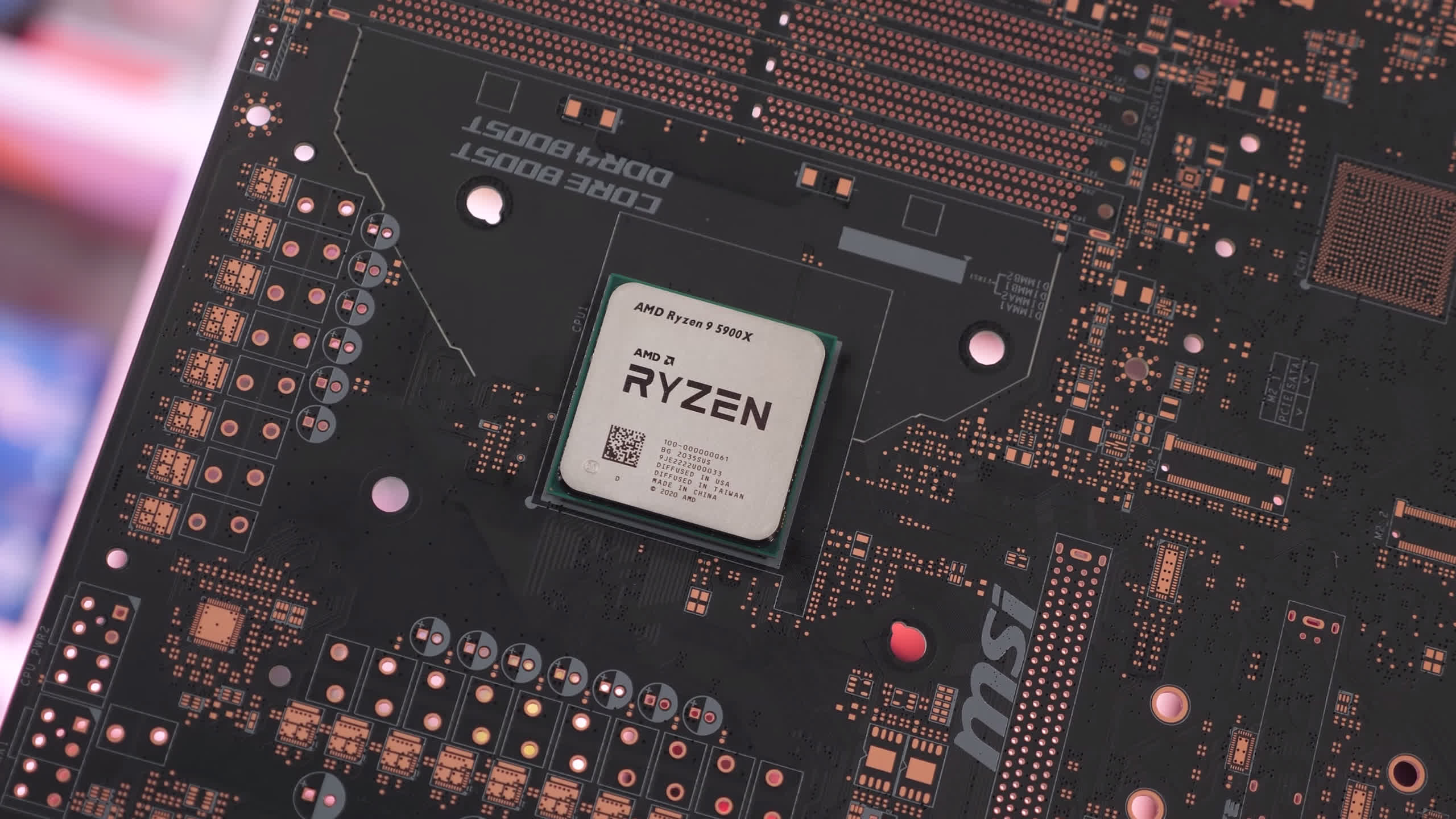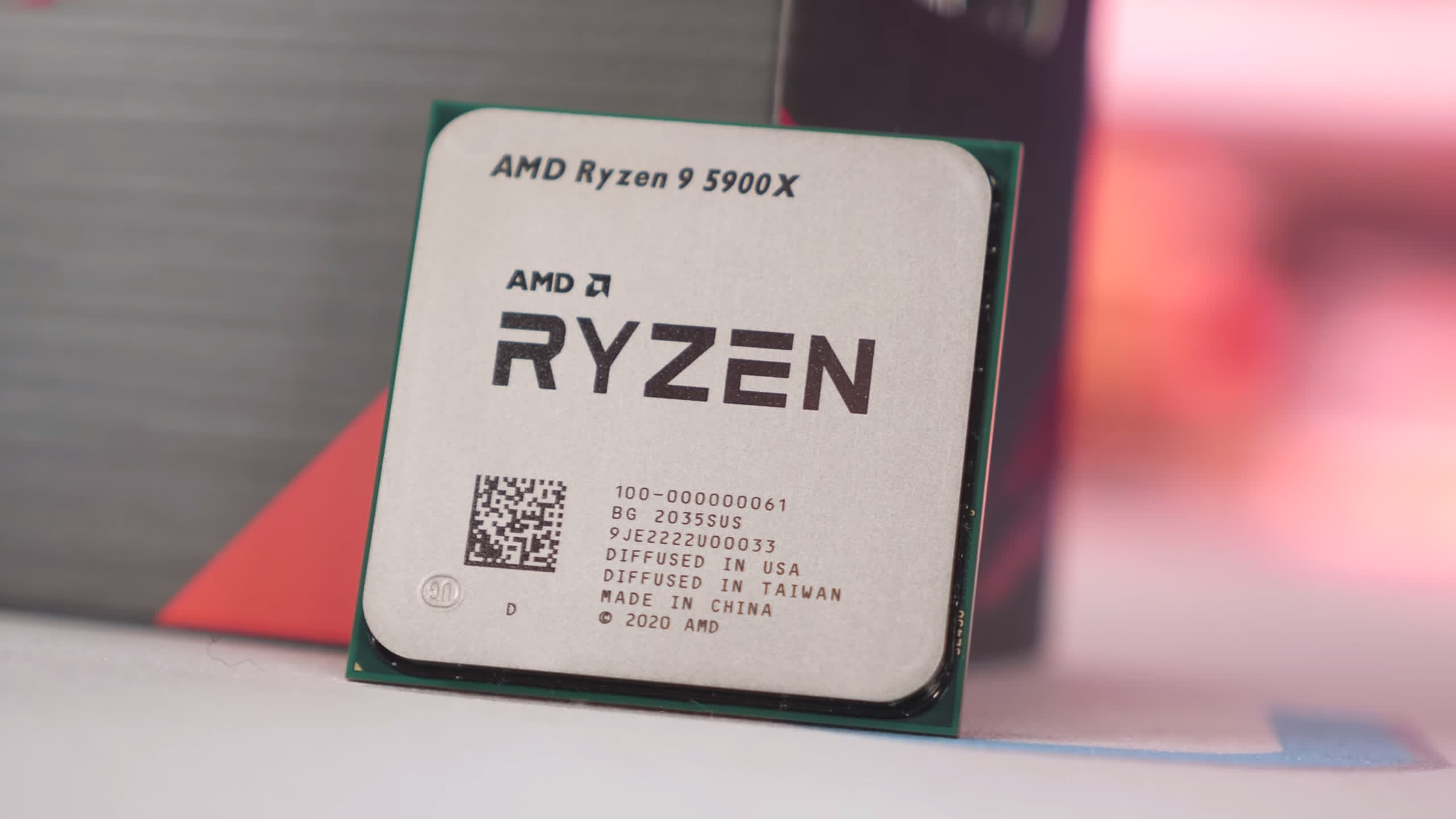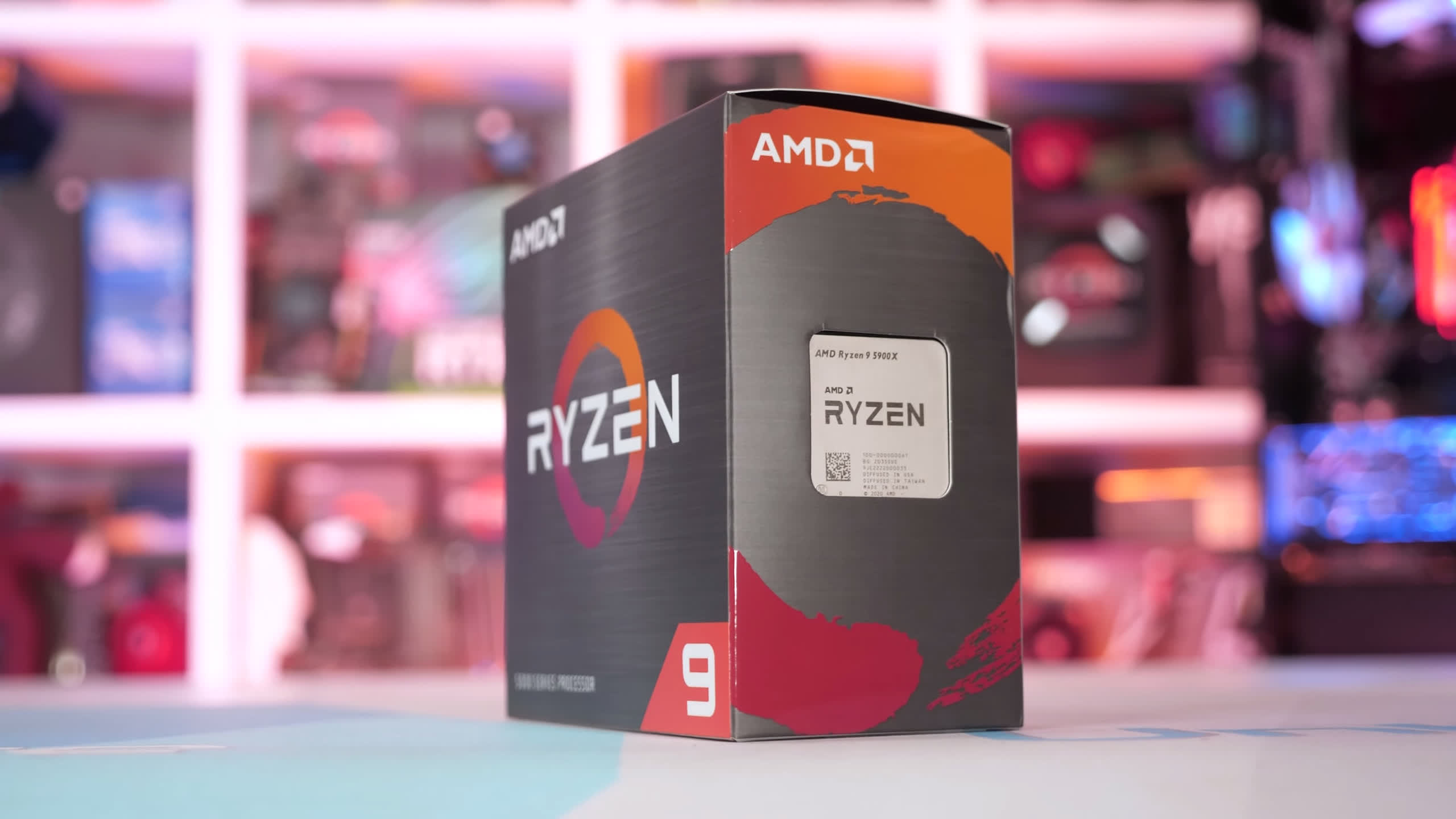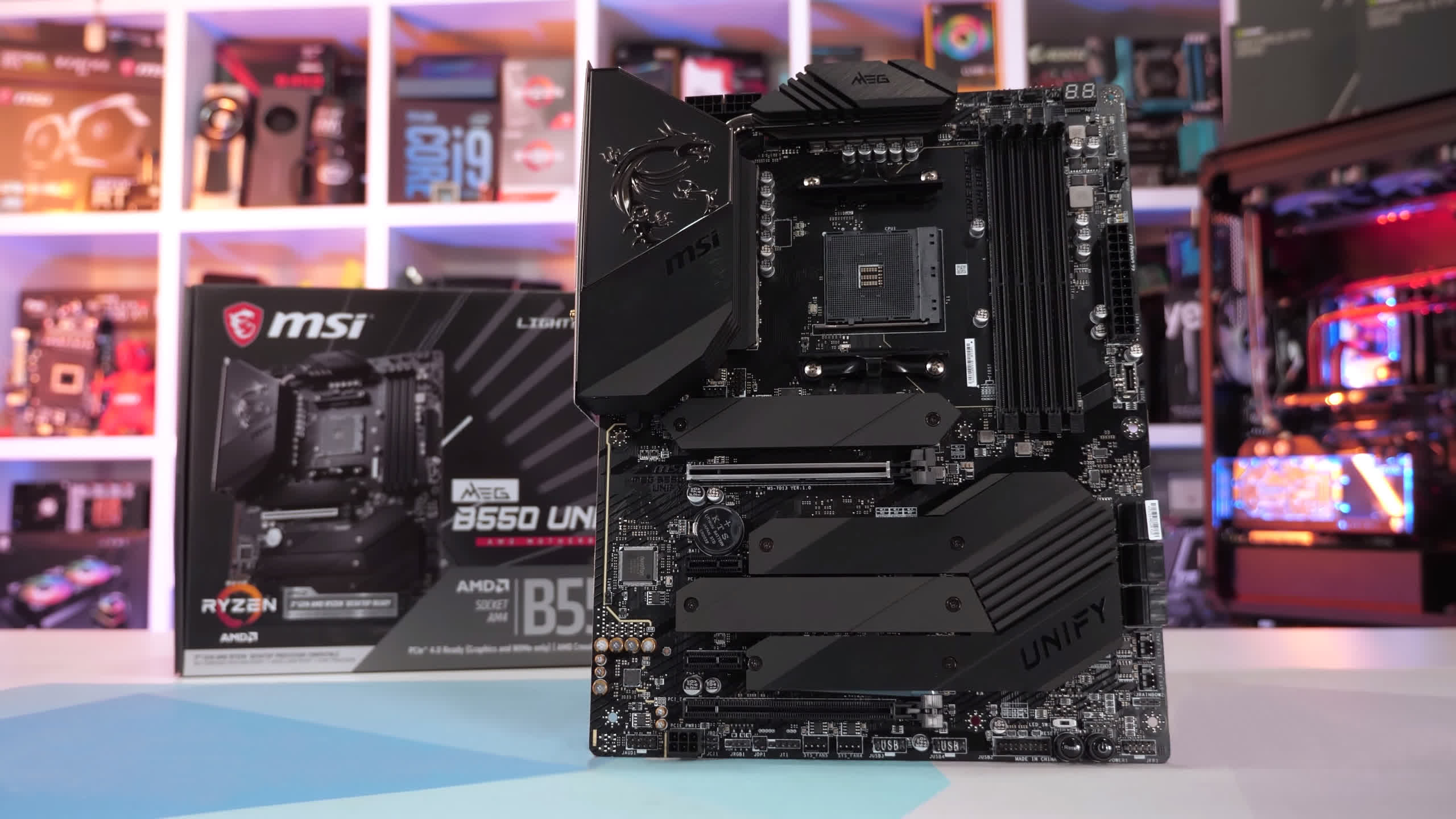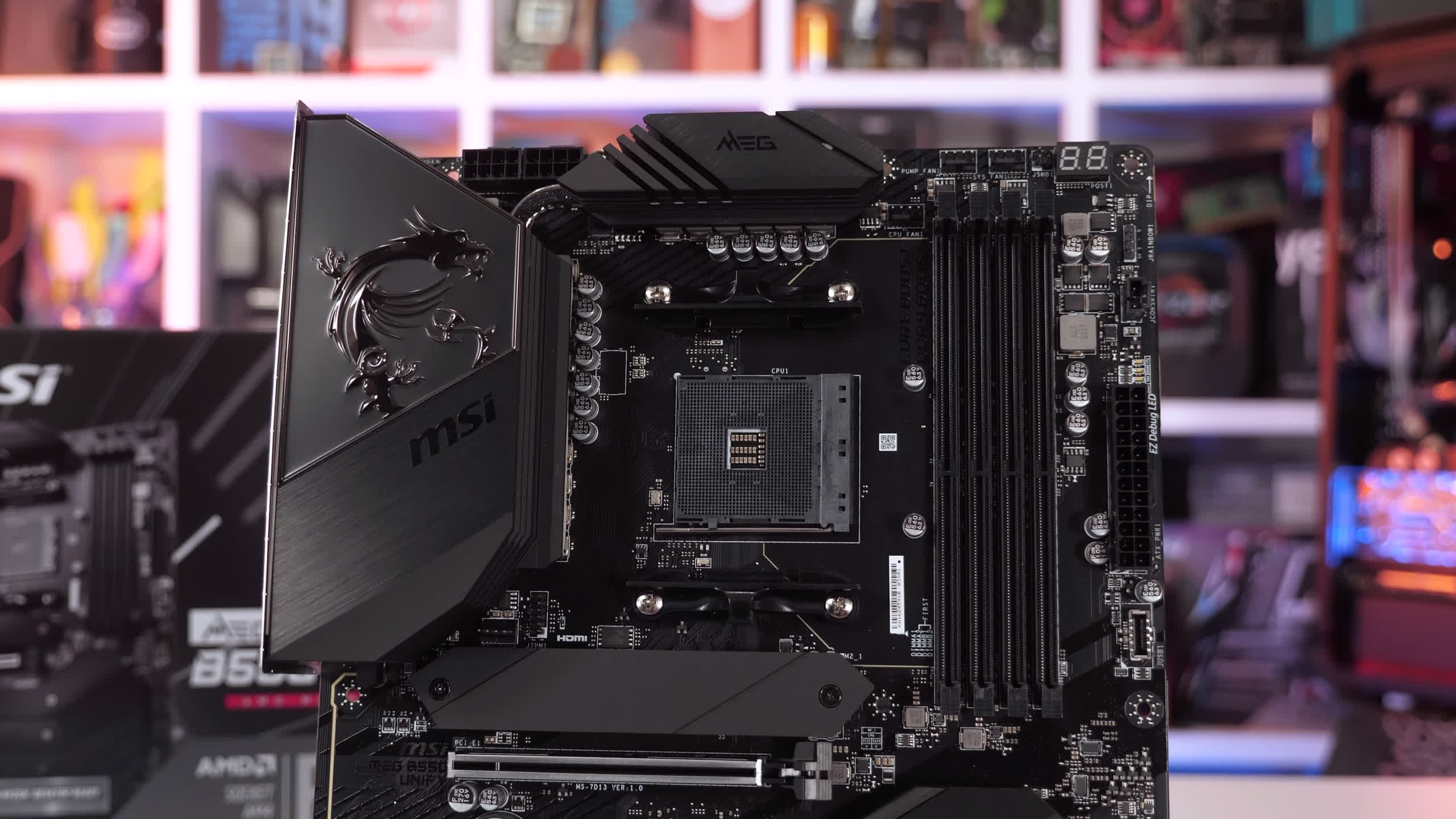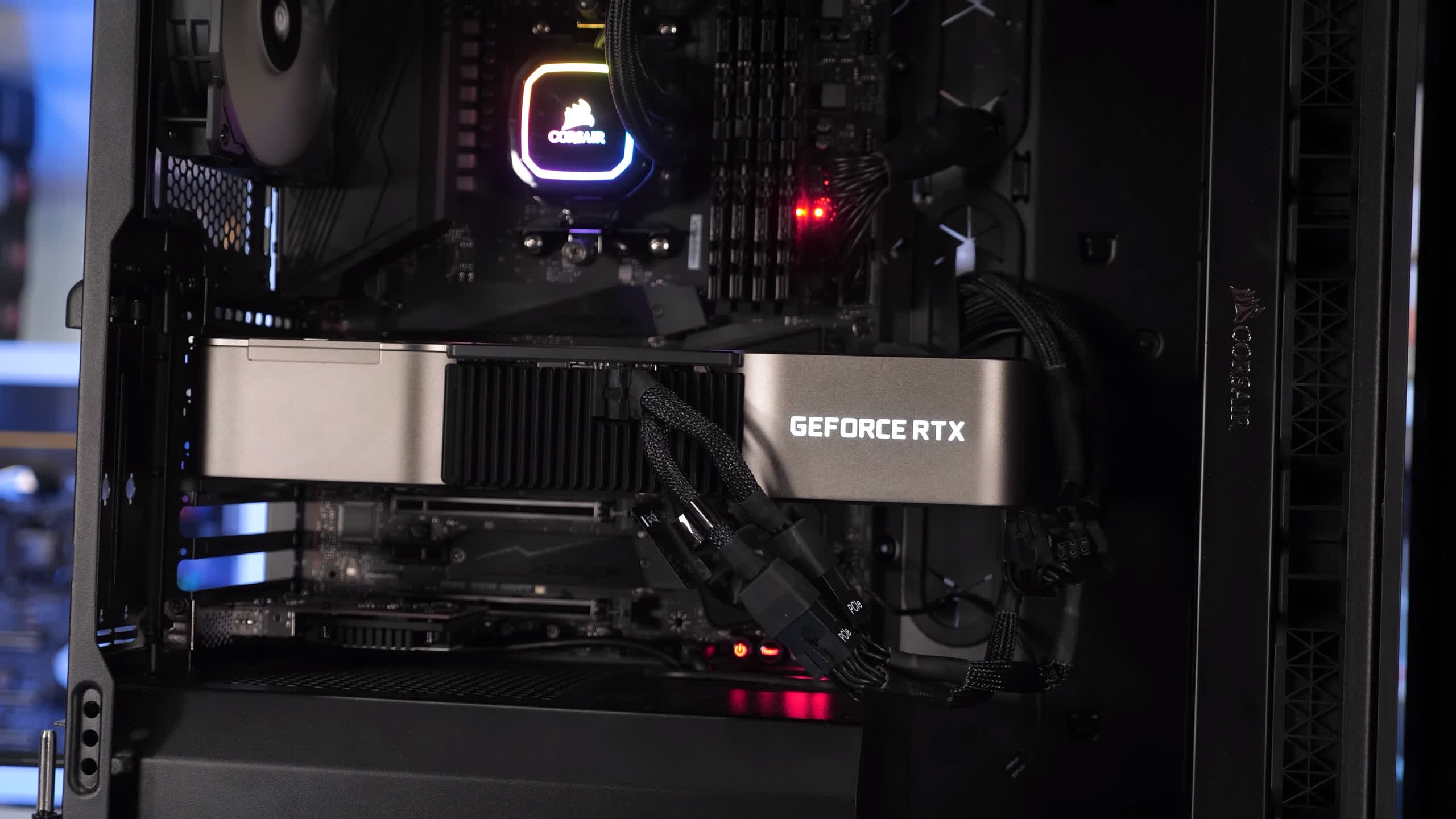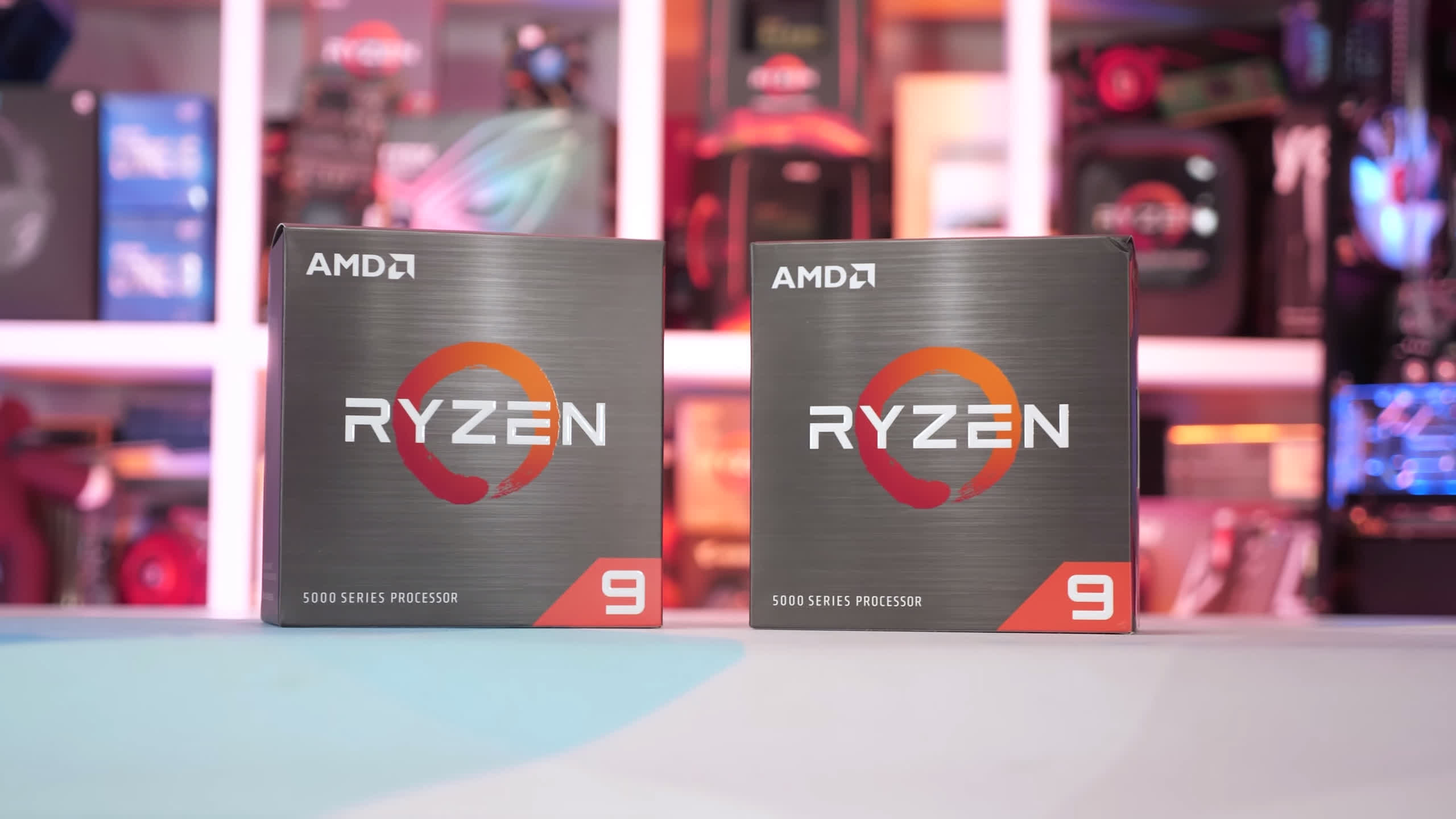For our first review of Ryzen 5000 we checked out the Ryzen 9 5950X, AMD's new $800 16-core, 32-thread AM4 processor. Today, we're looking at the Ryzen 9 5900X, the 12-core, 24-thread CPU that's available for $550.
That makes the 5900X ~8% cheaper per core when compared to its bigger brother as AMD can get away with charging a premium for the 16-core model given it faces no real competition.
The 12-core R9 5900X is priced to compete with Intel's Core i9-10900K. Normally, the 10-core Intel processor would retail for $530, but due to supply issues, it typically sells for $550 or $600, which means the 10900K and 5900X are comparable in terms of price.
Now we need to find out how they stack up in terms of performance.
The 5950X is a beast, so we're expecting good things from the 5900X which brings down the core count as the only major change. The clock speeds are much the same, the boost frequency has been lowered by 100 MHz, while the base frequency increased by 300 MHz. Because both CCDs are still active, it packs a total L3 cache of 64 MB.
Once again, we're not going to concern ourselves with Zen 3 architectural improvements on this review, rather we'll skip that and jump into the benchmarks.
Before we do though, let's take a quick look at yet another new AM4 motherboard. In yesterday's review we showcased the Asus ROG Crosshair VIII Dark Hero, and now we're getting our first look at the MSI B550 Unify, a new B550 board that includes... well, pretty much everything.
The highlights include a 16-phase VRM using Infineon TDA21490 90A powerstages, a 6-layer PCB with 2oz thickened copper, all aluminum extended heatsinks with dedicated VRM heatpipe, four M.2 slots with double sided M.2 Shield Frozr cooling and DDR4 A-XMP support for up to DDR4-5800.
There is also a Unify-X version with just two memory DIMMs. MSI claims the Unify-X can do DDR4-5800 with 4000 G series processors and DDR4-5300 with 3rd-gen Ryzen. While the standard Unify that we have can achieve DDR4-5600 with 4000 G-series though they have yet to make any Ryzen 5000 series claims.
Later this month we'll put together a detailed Zen 3 memory performance guide and we'll use the standard Unify for the bulk of our testing. This MSI board is priced at $290, so it's a Gigabyte B550 Master competitor. We'll go back to more motherboard testing after our slew of Ryzen reviews.
To keep things simple for all our new Ryzen 5000 testing, we're using the same MSI X570 Godlike motherboard along with four 8GB G.Skill TridentZ DDR4-3200 CL14 memory modules for a 32GB capacity. Cooling all systems is the Corsair iCUE H150i Elite Capellix AIO.
For all the productivity testing we're using an RTX 2080 Ti, but for the gaming benchmarks we've updated all our numbers with the RTX 3090, so let's get into the graphs...
Benchmarks
First up we have Cinebench R20 and wow, 8487 points is pretty insane. That's a 17% increase from the 3900X, making the 5900X just 8% slower than the 3950X. These are impressive numbers considering the CPU packs 25% fewer cores. When compared to the Core i9-10900K which is a rough match in price, the new 5900X comes in 32% faster, although it does have 20% more cores.
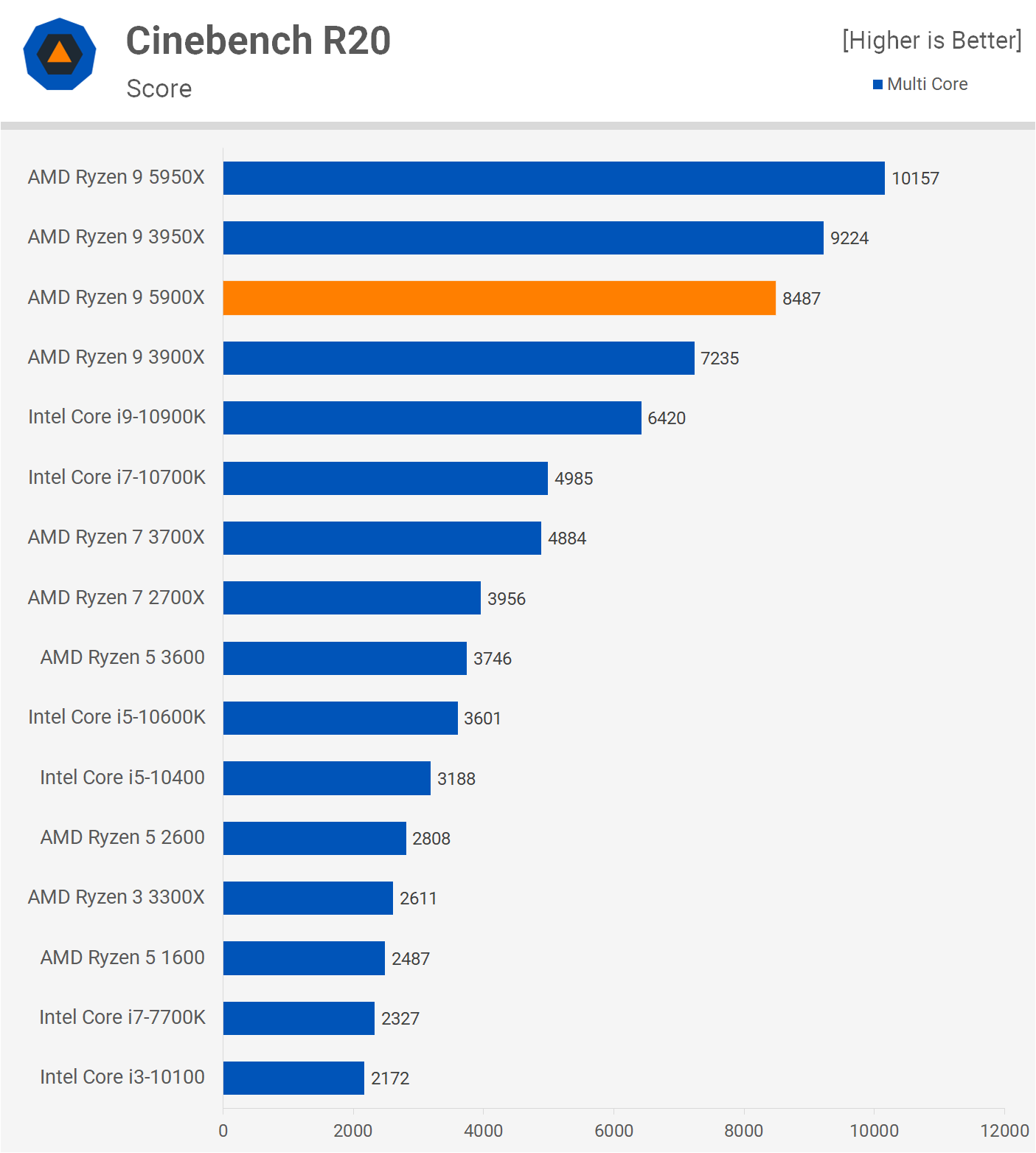
Running the single core benchmark reveals why the 5900X is so much faster than the 10900K in Cinebench R20. Here we're looking at a 16% boost to single-thread performance. It's also a 23% improvement from the 3900X, and with a similar single core score to that of the 5950X, we're expecting strong gaming performance.
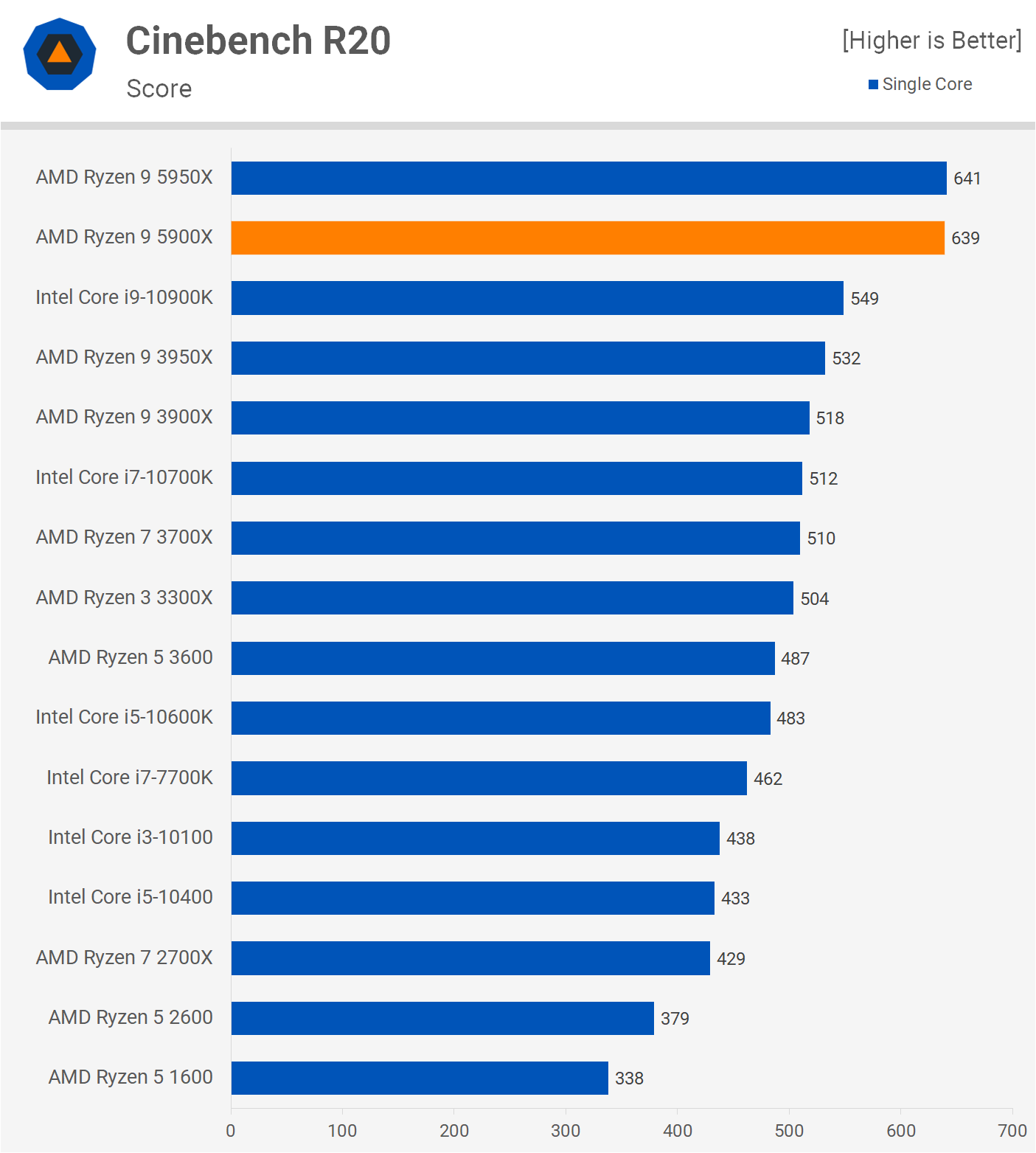
We also watched how the 5900X clocks in each of the Cinebench R20 tests. For the multi-core test where all cores are heavily loaded, the 5900X clocks at around 4.3 GHz. Meanwhile, AMD advertises a base clock frequency of 3.7 GHz.
In the Cinebench single core test, the 5900X typically operated at 4.9 GHz, which is 100 MHz over the advertised spec. AMD in this instance has made sure the max boost frequency is not only easily achieved, but can be exceeded to avoid the drama seen with Zen 2 and its boost clocks.
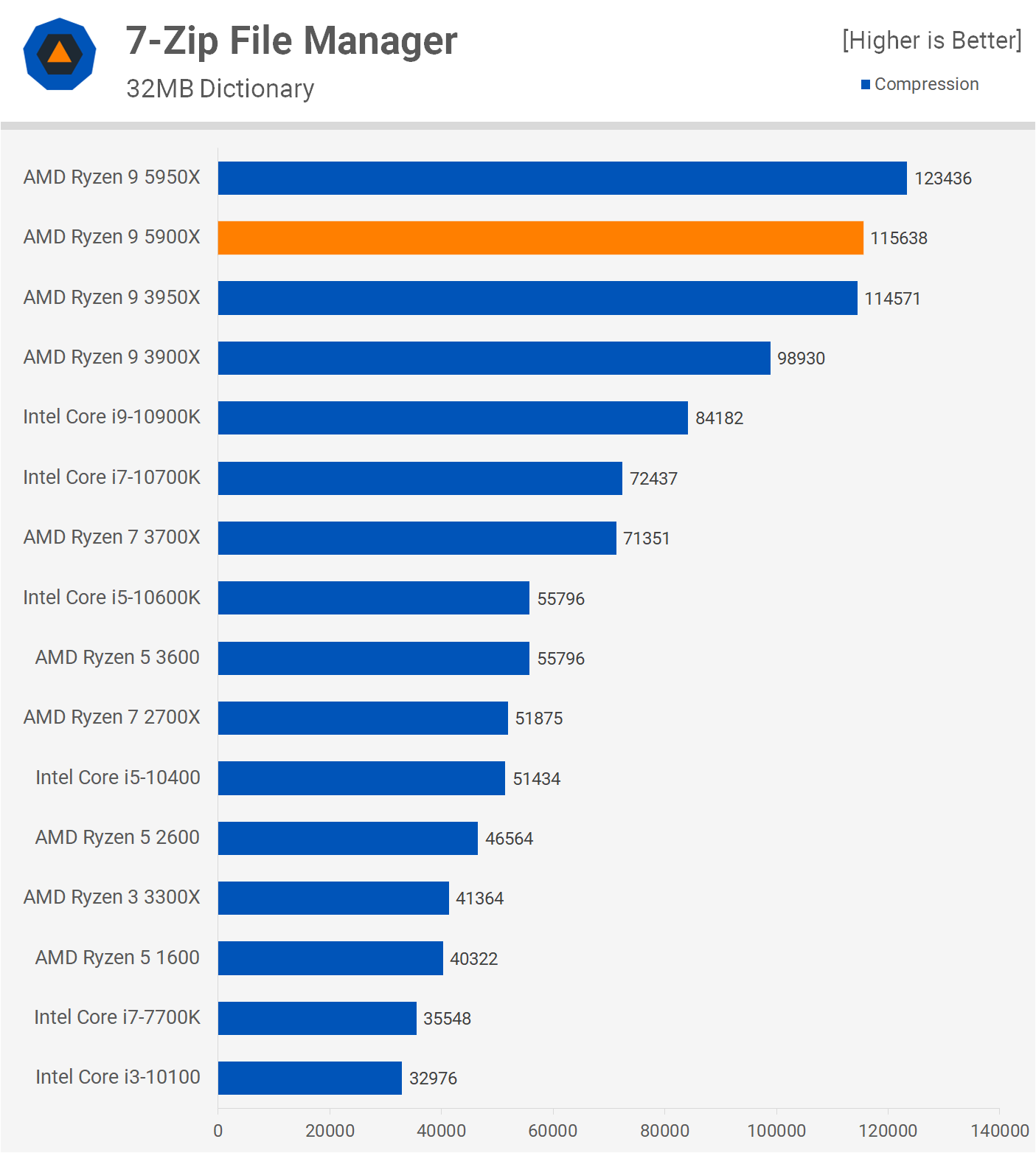
7-zip looks at compression performance and here the 5900X is 17% faster when compared to its predecessor. It's also able to edge out the 3950X, making it 37% faster than the 10900K.

When decompressing we find that SMT is more useful and as a result the 3950X is able to pull ahead. That said, the 5900X is 8% slower and is still offering a substantial 18% performance boost over the 3900X. As a result, it's much faster than Intel's best, beating the 10900K by a whopping 43% margin.
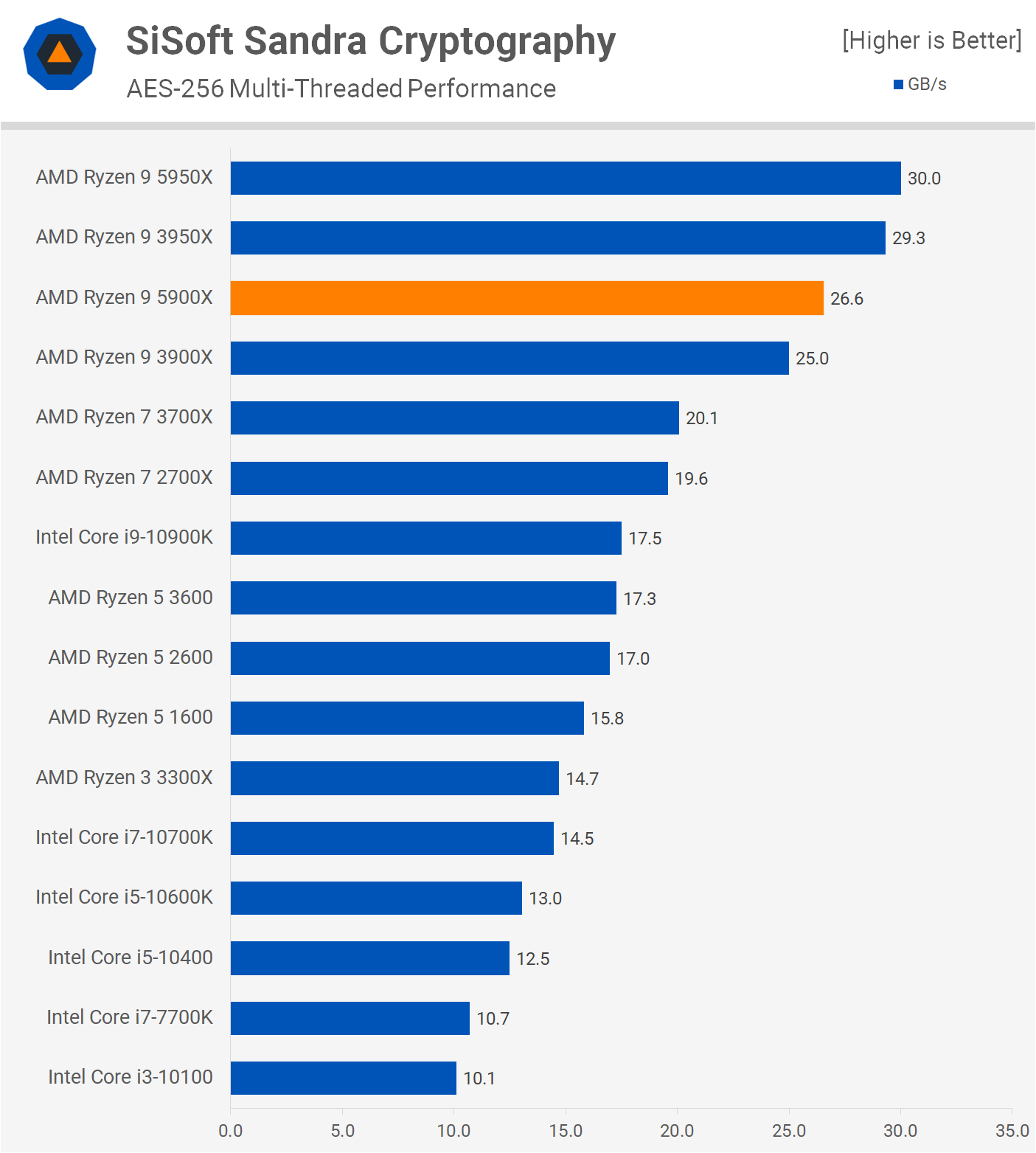
AES encryption performance is slightly improved with Zen 3 and this is an area where Zen 2 already excelled. Therefore it's no surprise to see the 5900X dominating the 10900K by a huge 52% margin.
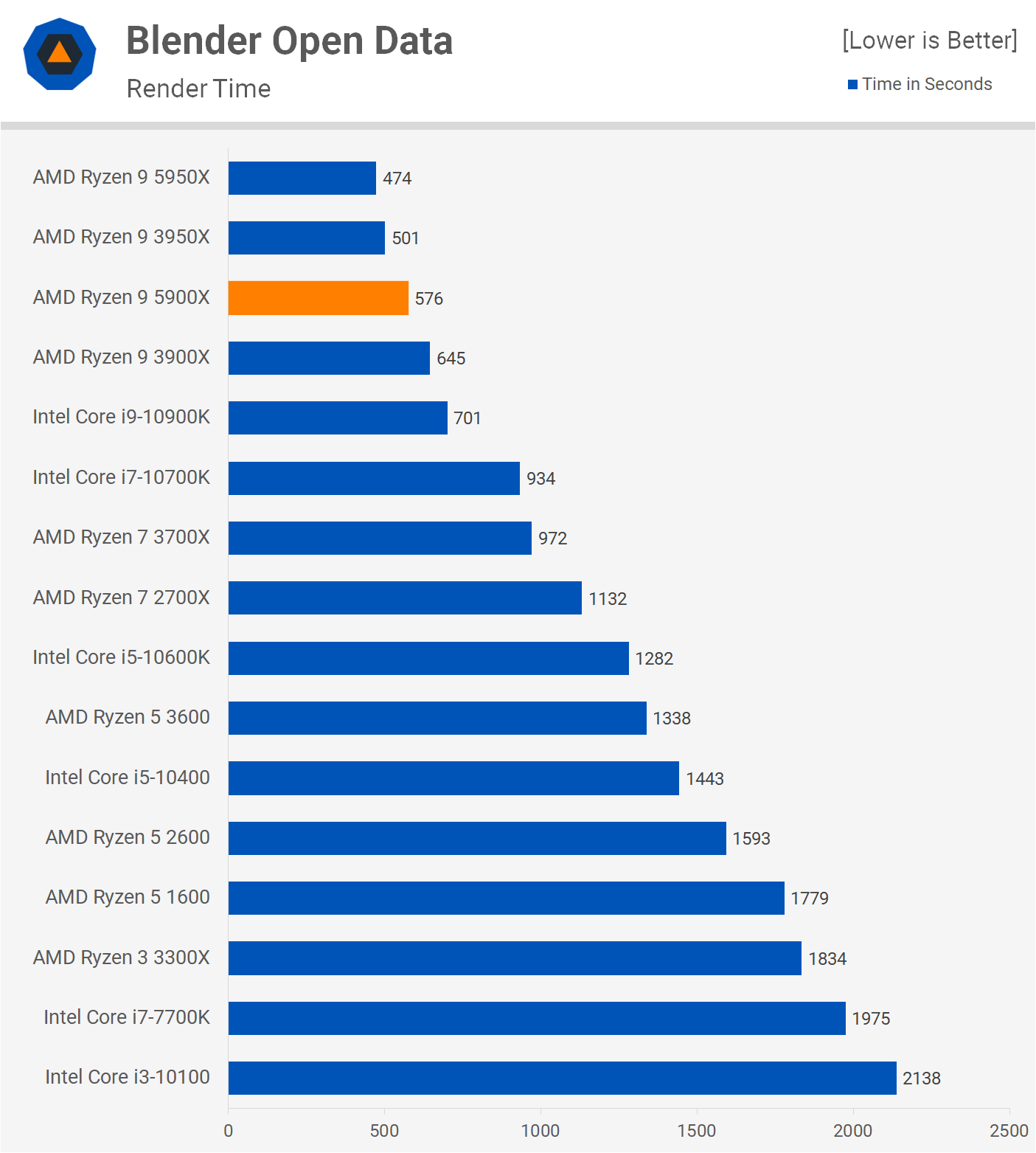
Moving on to Blender, here we're looking at a 12% performance boost for the 5900X over the 3900X and that meant it was 22% faster than the 10900K.
When compared to the 3950X it was 13% slower and then 18% slower than the 5950X.

We found when testing the 5950X that the new Zen 3 architecture absolutely shreds in V-Ray, and we're seeing exactly that with the 12-core model, too. Here the 5900X basically matched the older 16-core 3950X and that meant it was 23% faster than its predecessor and 32% faster than its primary competitor, the 10900K, so a bit of a shellacking there.
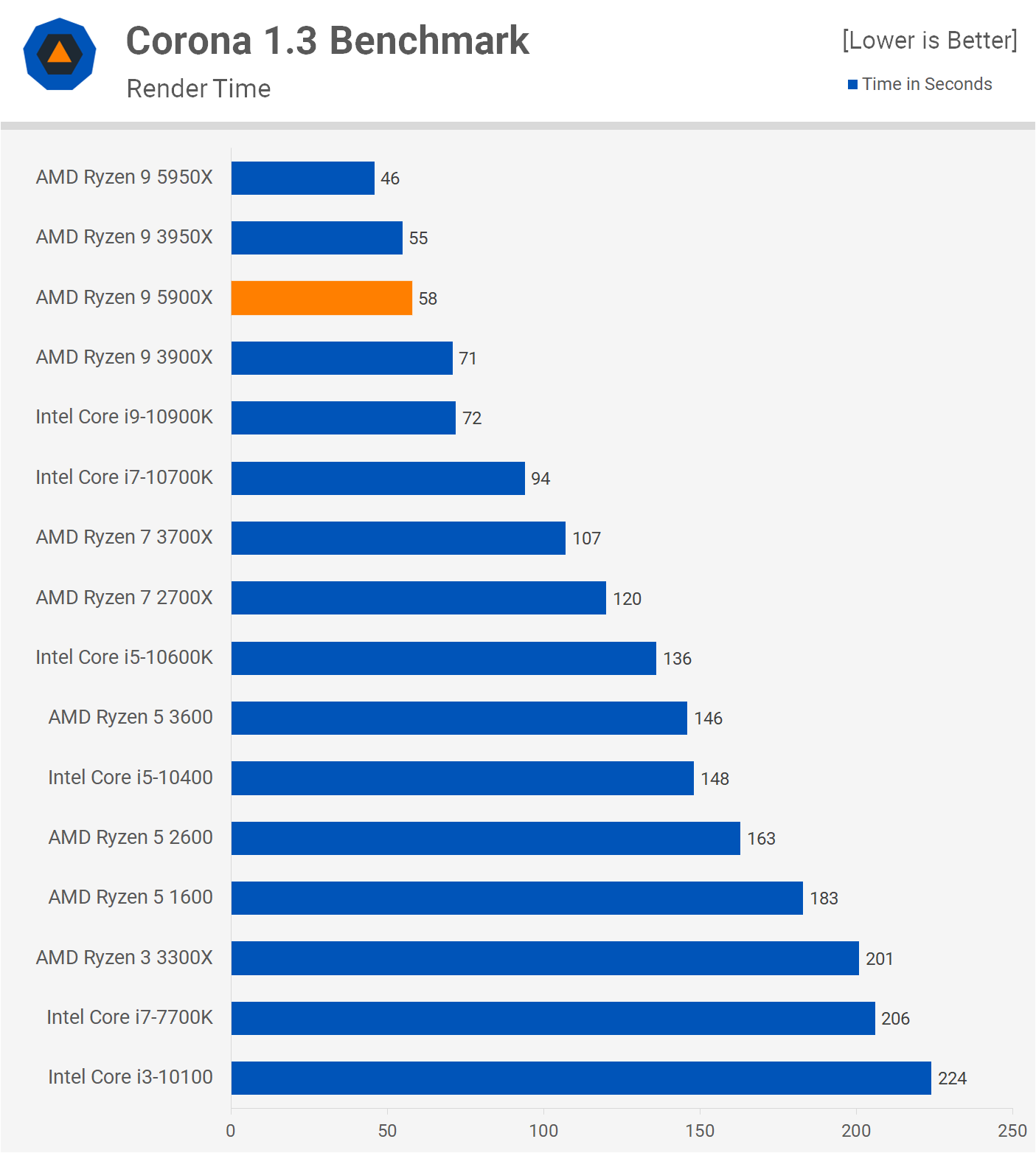
The last rendering benchmark we have is Corona, where the 5900X is much faster than the 3900X, boosting performance by 22%, delivering 3950X-like performance. That's a big gen-on-gen improvement and it also meant the 5900X was 24% faster than the 10900K.
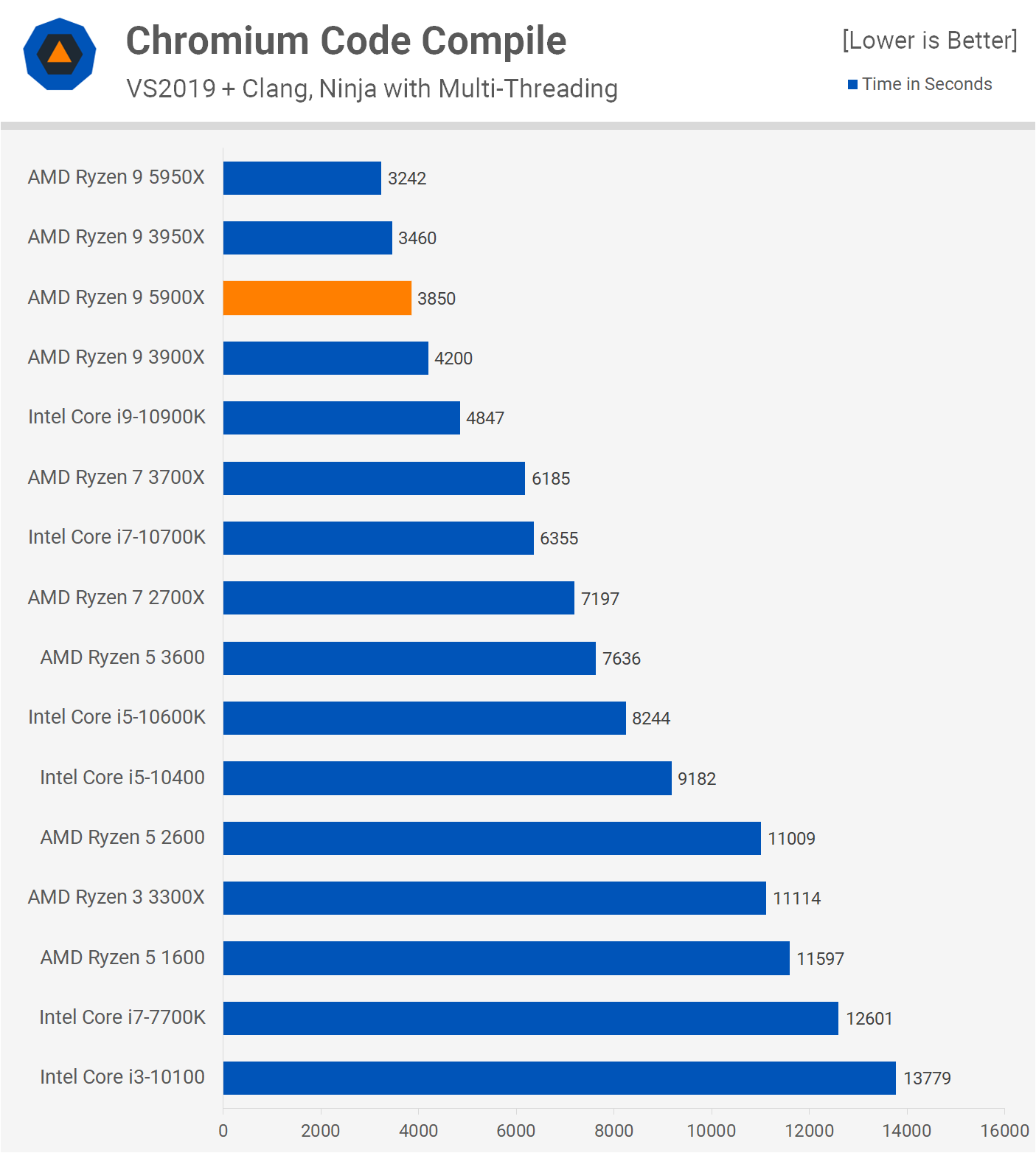
For those of you interested in code compilation performance we see that the 5900X is just 9% faster than the 3900X, so one of the smaller gains we've seen so far, in fact it might be the smallest.
Despite that, it managed to beat the 10900K by a convincing 26% margin.
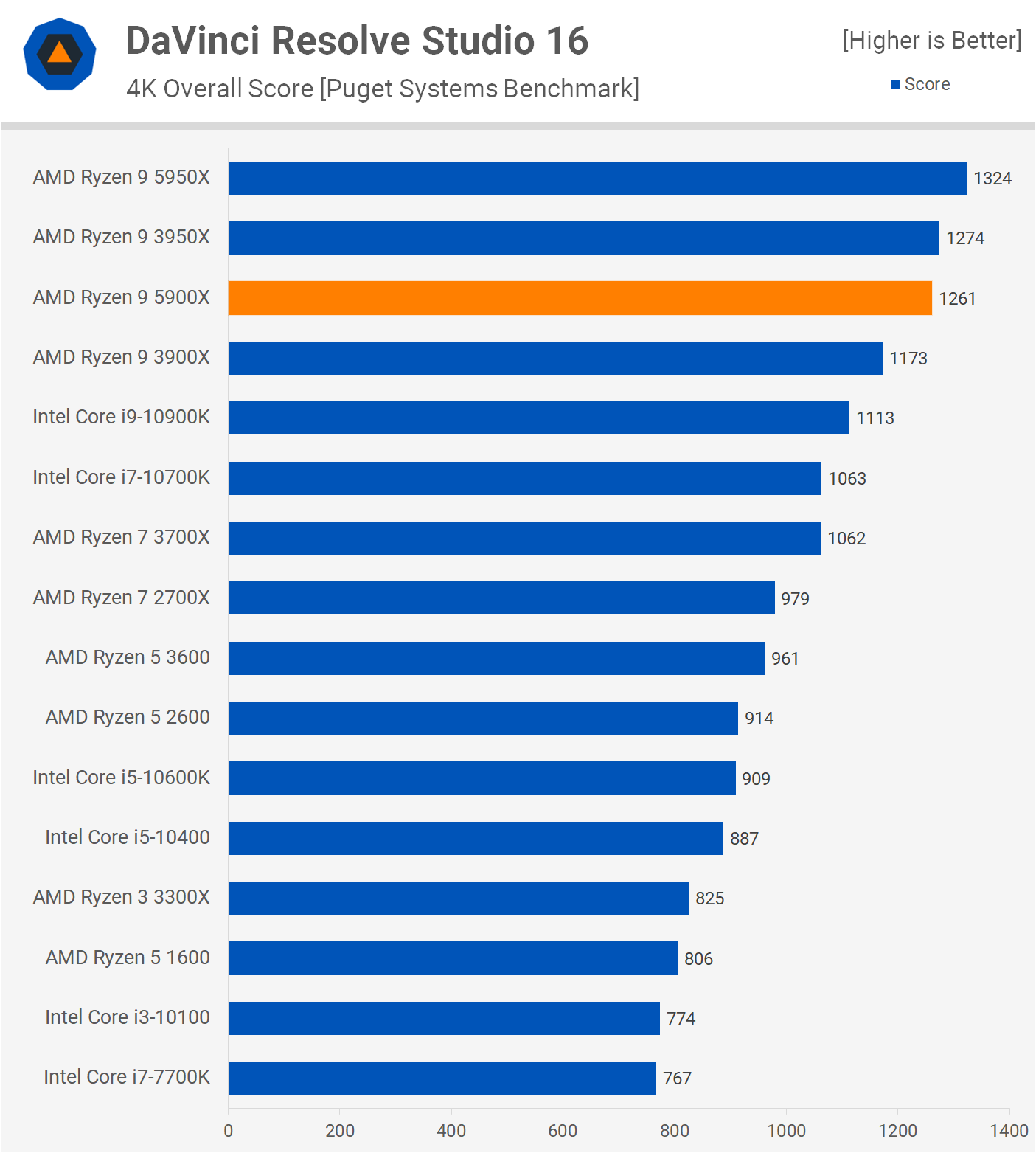
DaVinci Resolve Studio 16 using the Puget Systems Benchmark actually provides the weakest gains we've seen yet, where the 5900X was just 8% faster than the 3900X, roughly matching the 3950X.
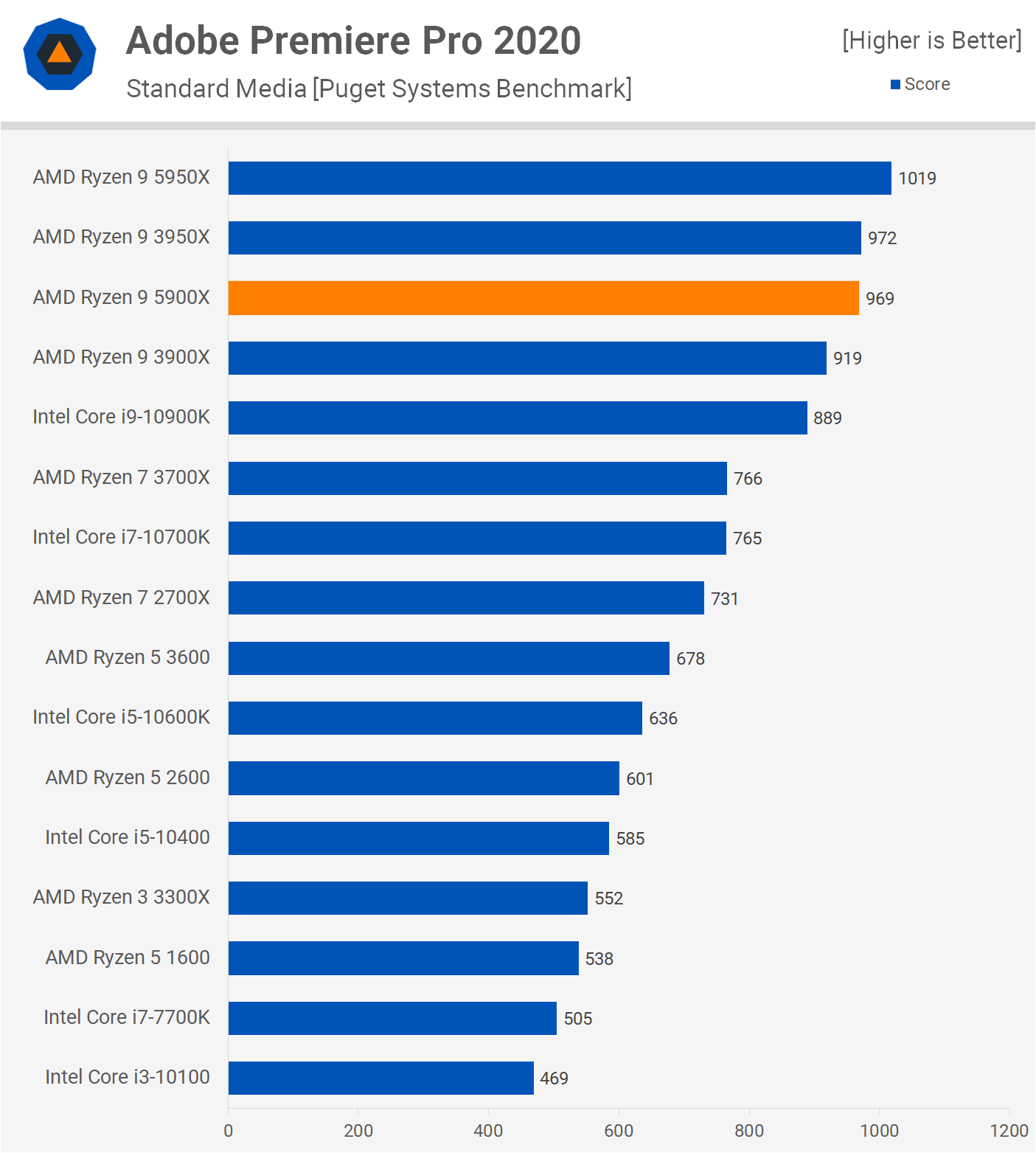
Adobe Premiere Pro 2020 lowers the bar even further, here the 5900X was just 5% faster than the 3900X while it was just 9% faster than the 10900K. Still a 9% performance advantage for roughly the same money is hardly anything to sneeze at, certainly given it appears to be a worst case scenario.

The strong single core performance comes in handy when testing with Photoshop, here the 5900X matched the 5950X and that meant it was 10% faster than the 10900K and a whopping 20% faster than its predecessor, the 3900X.

We're see strong performance gains over Zen 2 in After Effects, another application that relies heavily on single thread performance. Here the 5900X was 15% faster than the 3900X and 13% faster than the 10900K, almost matching the 5950X.
Power Consumption
For measuring power consumption we monitored total system usage in Blender. The Ryzen 9 5900X matched the power usage of the 3900X, even though they both use the same 7nm process, Zen 3 is able to boost performance in Blender by 12%. Moreover, when compared to the 10900K, the 5900X reduced total system consumption by 23%.

In terms of temperatures, the Ryzen 9 3900X and 5900X were both tested in a 21C room on an open test bench using the Corsair iCUE H150i Elite Capellix AIO on the MSI X570 Godlike, installed inside the Corsair Obsidian 500D.
We could see that the 5900X runs 7 to 8 degrees cooler than the 3900X under the same test conditions, despite running at a slightly higher clock speed using the same 7nm process. Part of this will be down to 7nm maturity, but AMD has also included a number of architectural optimizations. These enhancements also allow for a slightly lower vcore which would have helped to reduce power consumption and therefore thermals.
Gaming Benchmarks
We have the same battery of gaming tests as yesterday's 5950X review using a GeForce RTX 3090. Going in the same order, we'll start with Far Cry New Dawn.
The 5900X matched the 5950X exactly with 128 fps making it 6% slower than the 10900K, but still a good overall result given the double-digit percentage improvement over the 3900X.

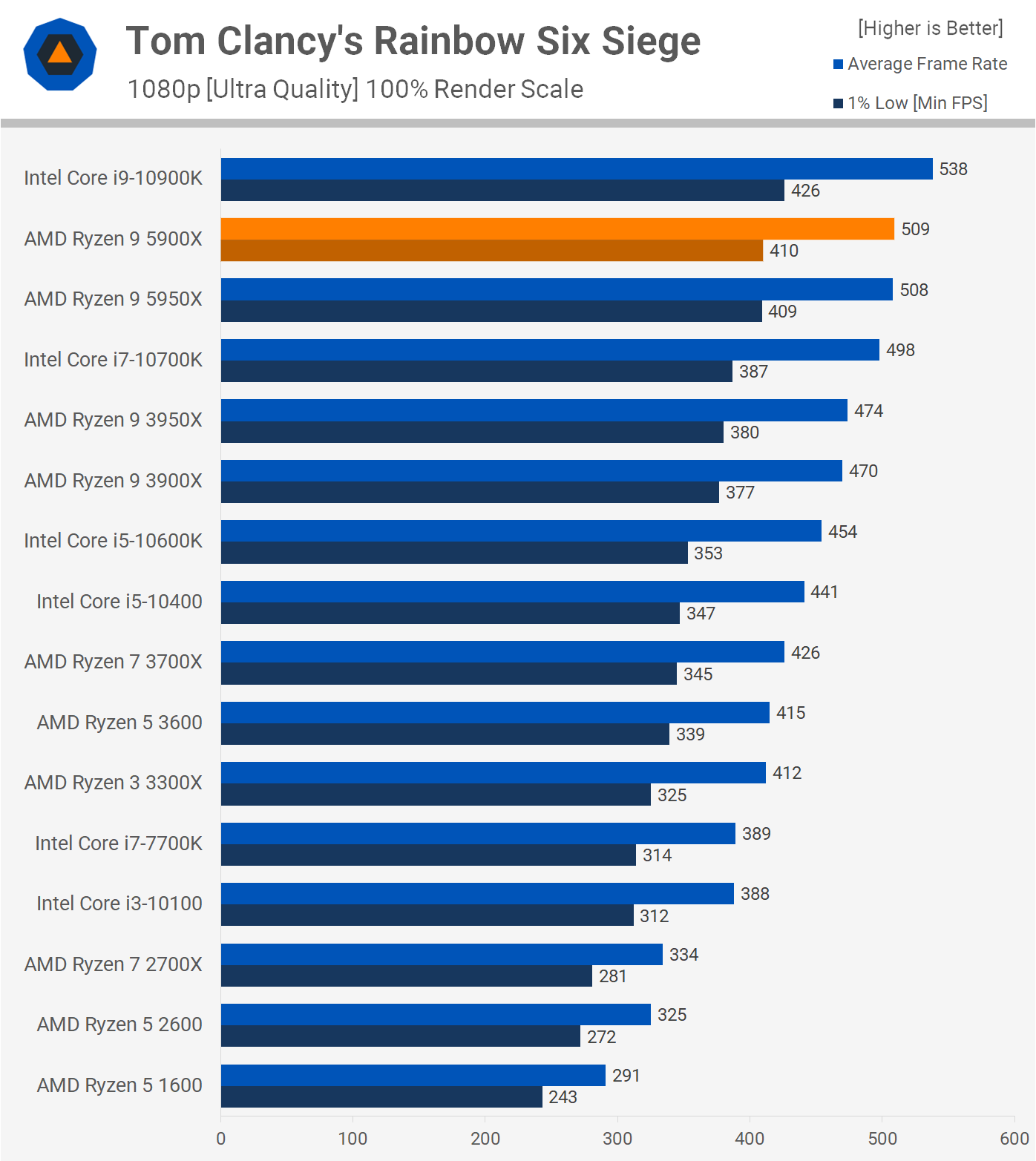
The 5900X also trails the 10900K in Rainbow Six Siege by a small 5% margin. We see the CPU matching the 5950X to provide an 8% boost over the 3900X. This was enough to edge out some of the lower core count Intel processors such as the 10700K.

In Watch Dogs: Legion we see strong performance from the 5900X, placing it on par with the 10700K and just 2 fps down on the 10900K. That's also a rather large 15% boost over the 3900X, which struggled against even the Core i5-10400 at this low resolution.
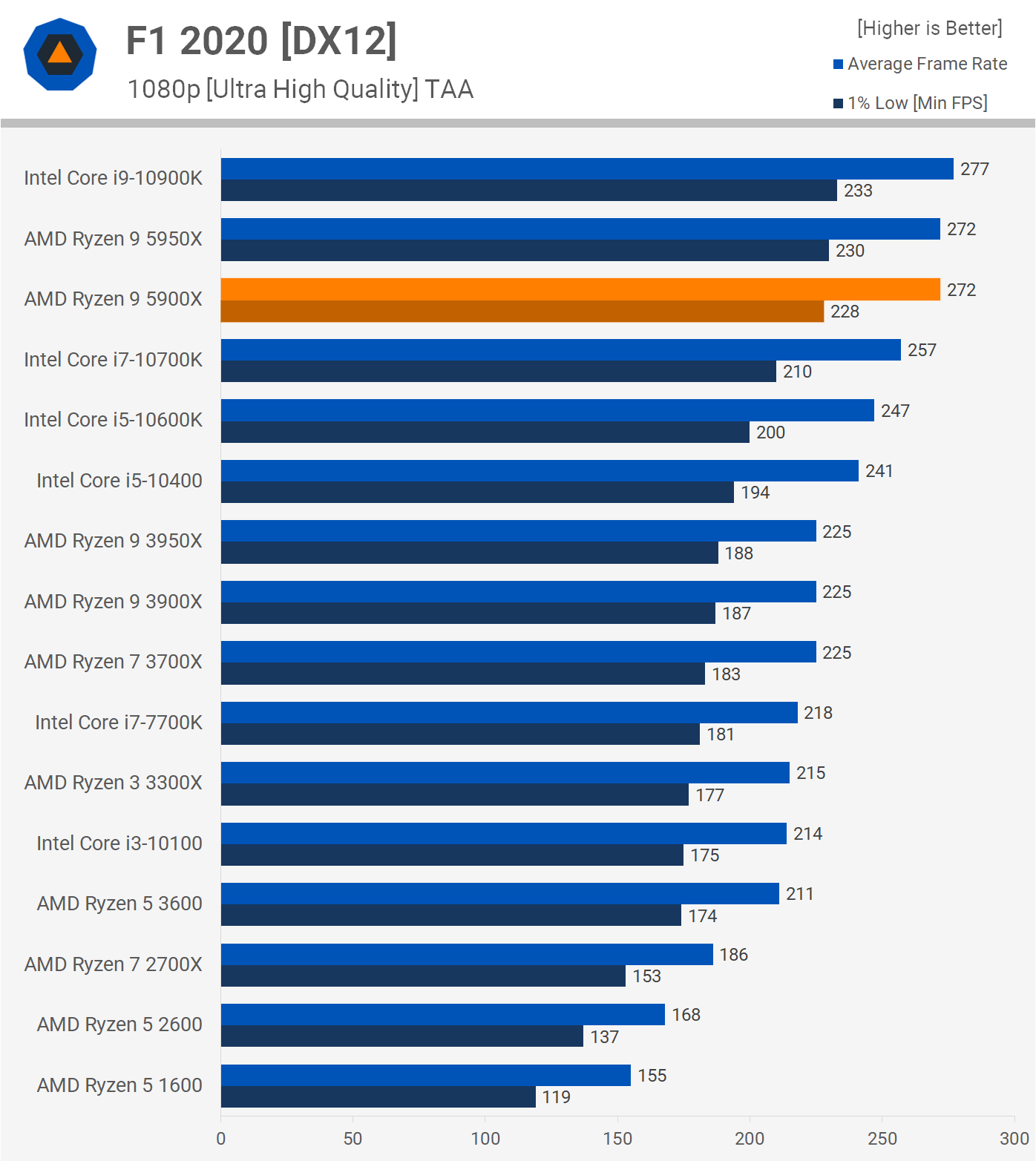
We're also seeing big performance gains in F1 2020 as the 5900X is 21% faster than the 3900X, hitting 272 fps with the RTX 3090. That's a great result which has the new 12-core Ryzen processor a mere 2% behind the 10900K. That's close enough to deem a draw in our book.

The performance uplift in Horizon Zero Dawn is solid. Here the 5900X is 15% faster than the 3900X and crucially is able to match the 10900K, edging it out by a few frames for what is basically the same performance.
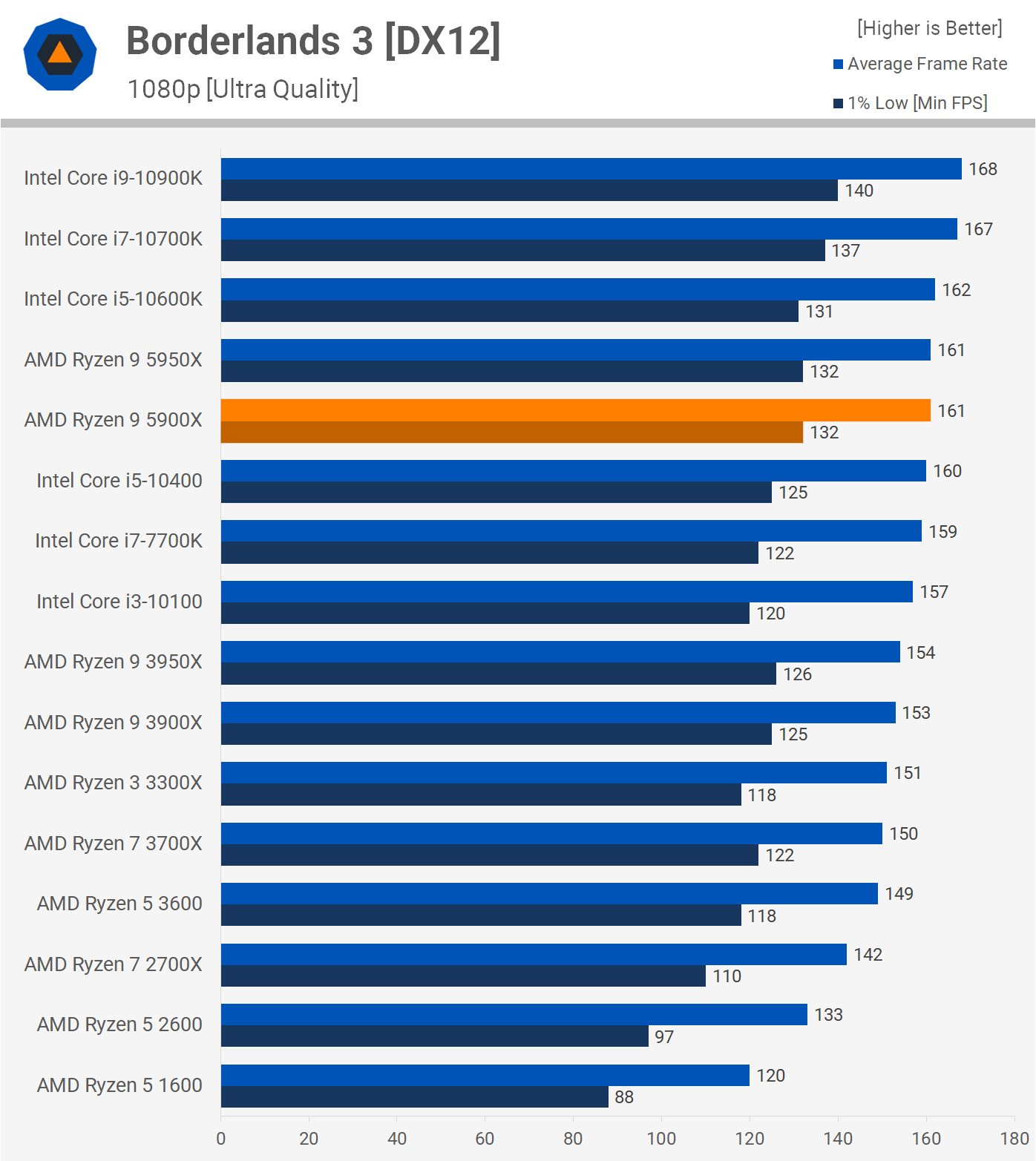
Performance in Borderlands 3 is only slightly improved. The 5900X was just 5% faster than the 3900X, though that was enough to get it within range of the 10900K, losing by just a 4% margin.
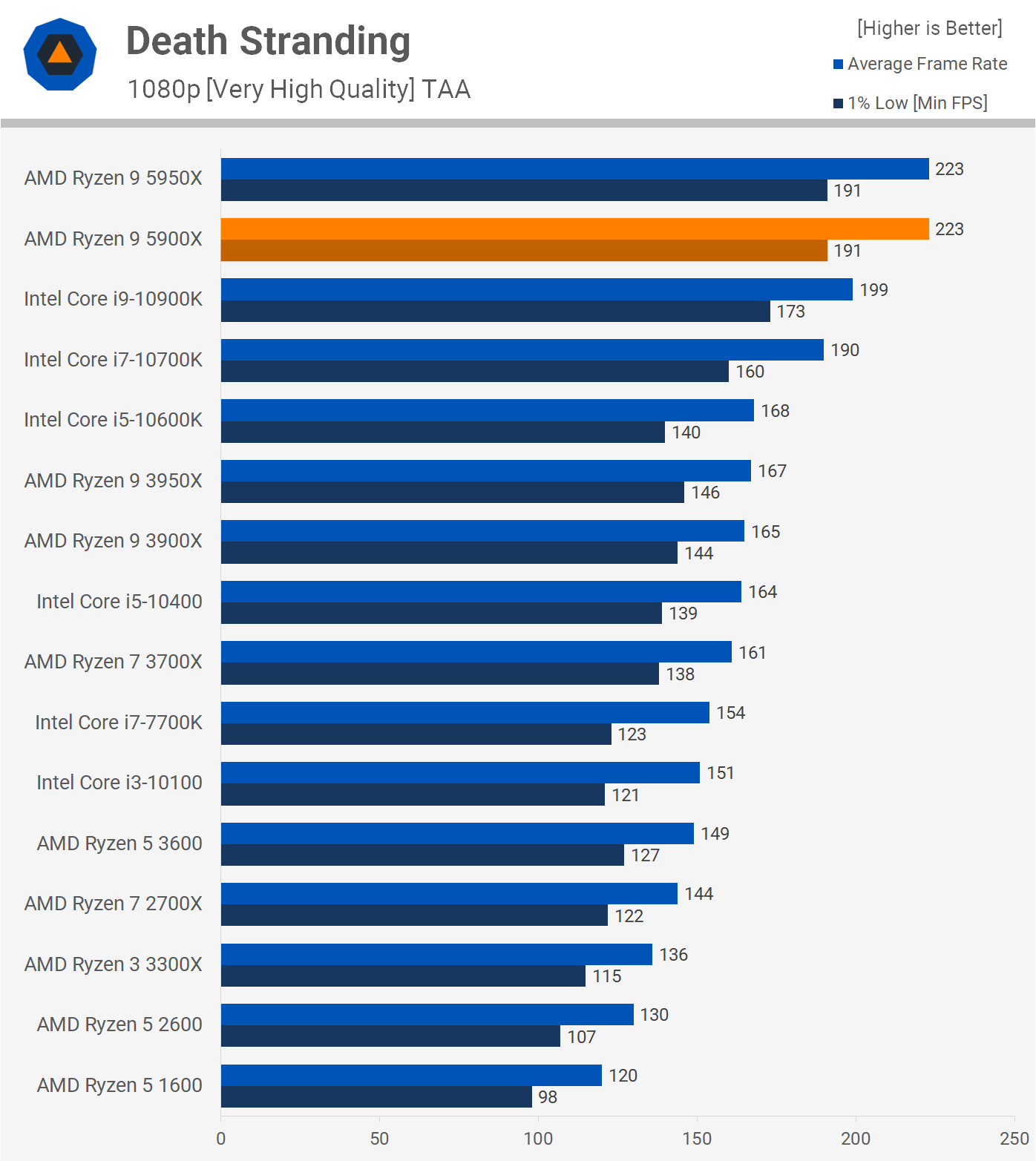
As seen before in the 5950X review, these Zen 3 processors are beasts in Death Stranding and the 5900X matched the 16-core model exactly, making it 12% faster than the 10900K and incredibly, 35% faster than the 3900X.
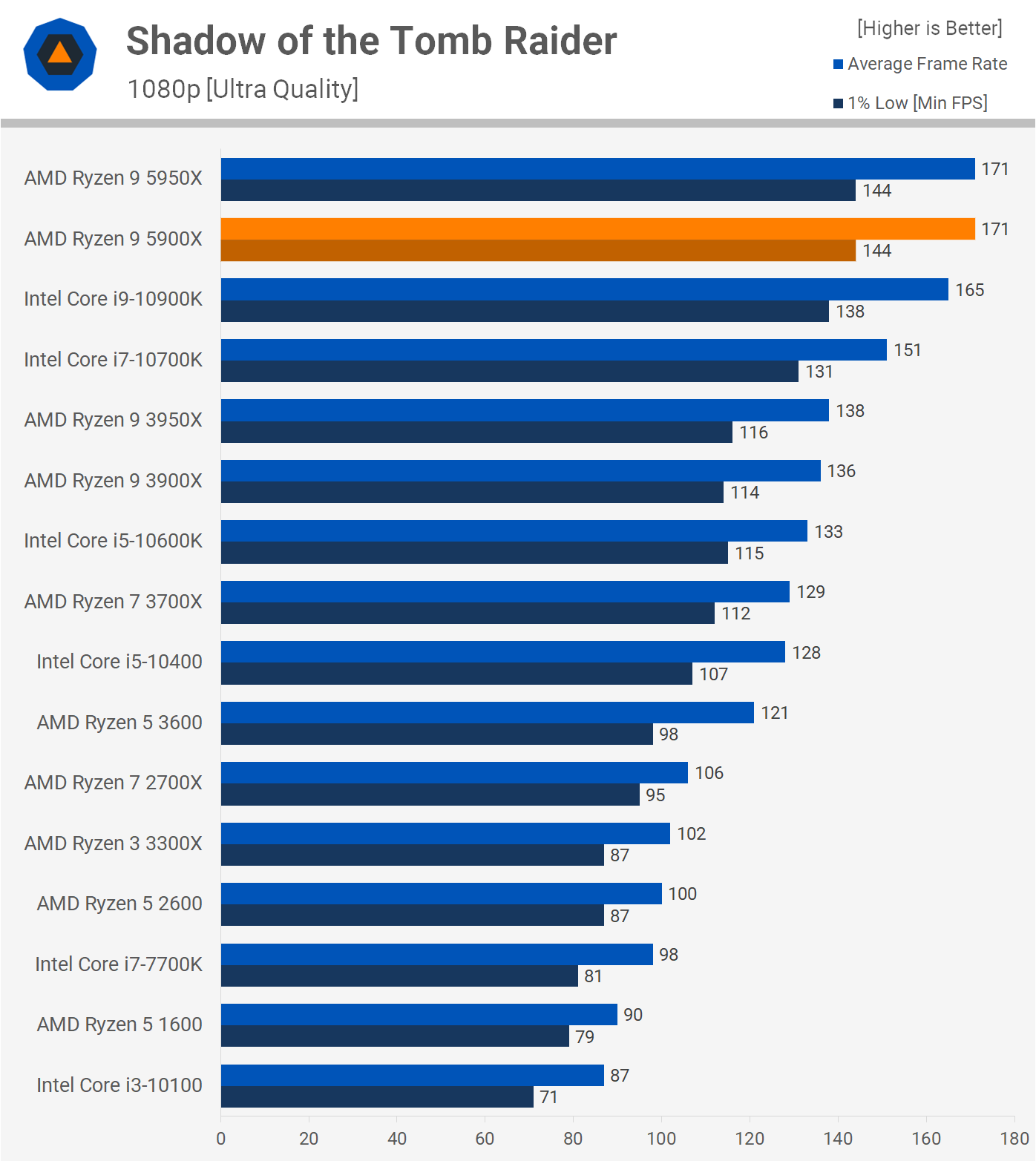
The 5900X is also able to match the 5950X in Shadow of the Tomb Raider, meaning it's 4% faster than the 10900K. A small win that's close enough to call a tie. The new processor is beating the old 3900X by a 26% margin in this title.

Hitman 2 performance is also solid. Here the 5900X couldn't match the 5950X, but was still 7% faster than the 10900K and 34% faster than the 3900X.

Performance in Star Wars: Squadrons is strong, matching the 10900K, though edging it out convincingly for 1% low performance. Then we see a 27% performance boost over the 3900X, taking the average frame rate from 247 fps to 314 fps.

The Serious Sam 4 results look good for Ryzen. The 5900X is 11% faster than the 10900K and a staggering 47% faster than the 3900X.
Gaming Performance Average
Here's a look at the average performance across the 11 games we tested. For the most part, the 5900X matches the 5950X in gaming, so it's no surprise to see them both deliver the same 214 fps average.
This also means that overall the 5900X and 10900K are on par when it comes to gaming performance, at least in our small sample of games. On that note, we're looking forward to a 40 game head to head benchmark with these processors.
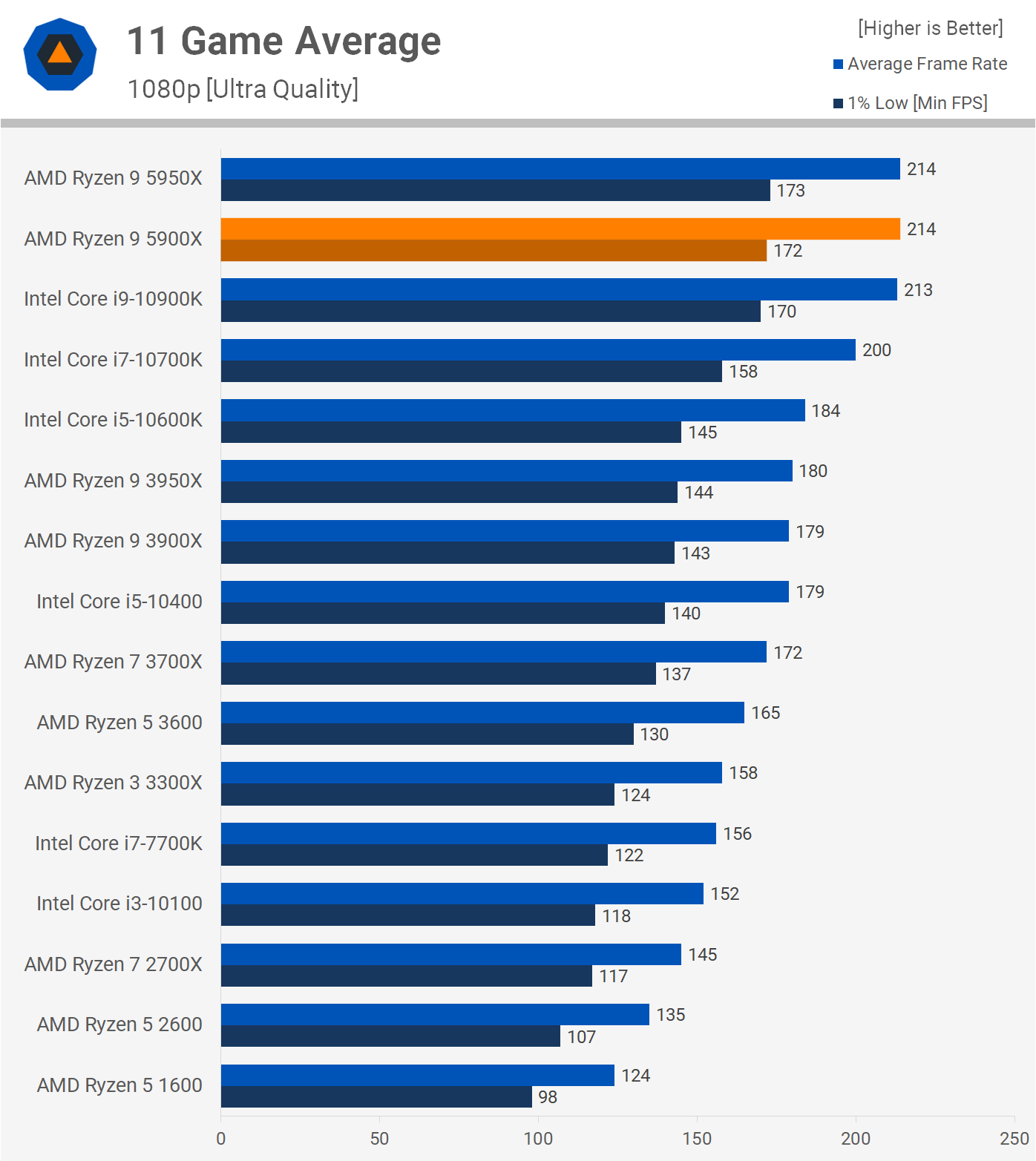
It's also impressive to see a 20% performance increase over the 3900X. We know AMD claimed a 19% IPC improvement, but seeing that translate into real world gains in games is something else.
Overclocking
We were able to hit an all-core 4.6 GHz overclock with the 5900X using 1.375v. This isn't quite as good as the 5950X's 4.7 GHz, but a solid all core overclock nonetheless. This boosted the Cinebench R20 multi-core performance by 7%, so it's not amazing and nothing like the 20% boost the 5950X received, but it's free performance assuming you have a decent cooler and motherboard.
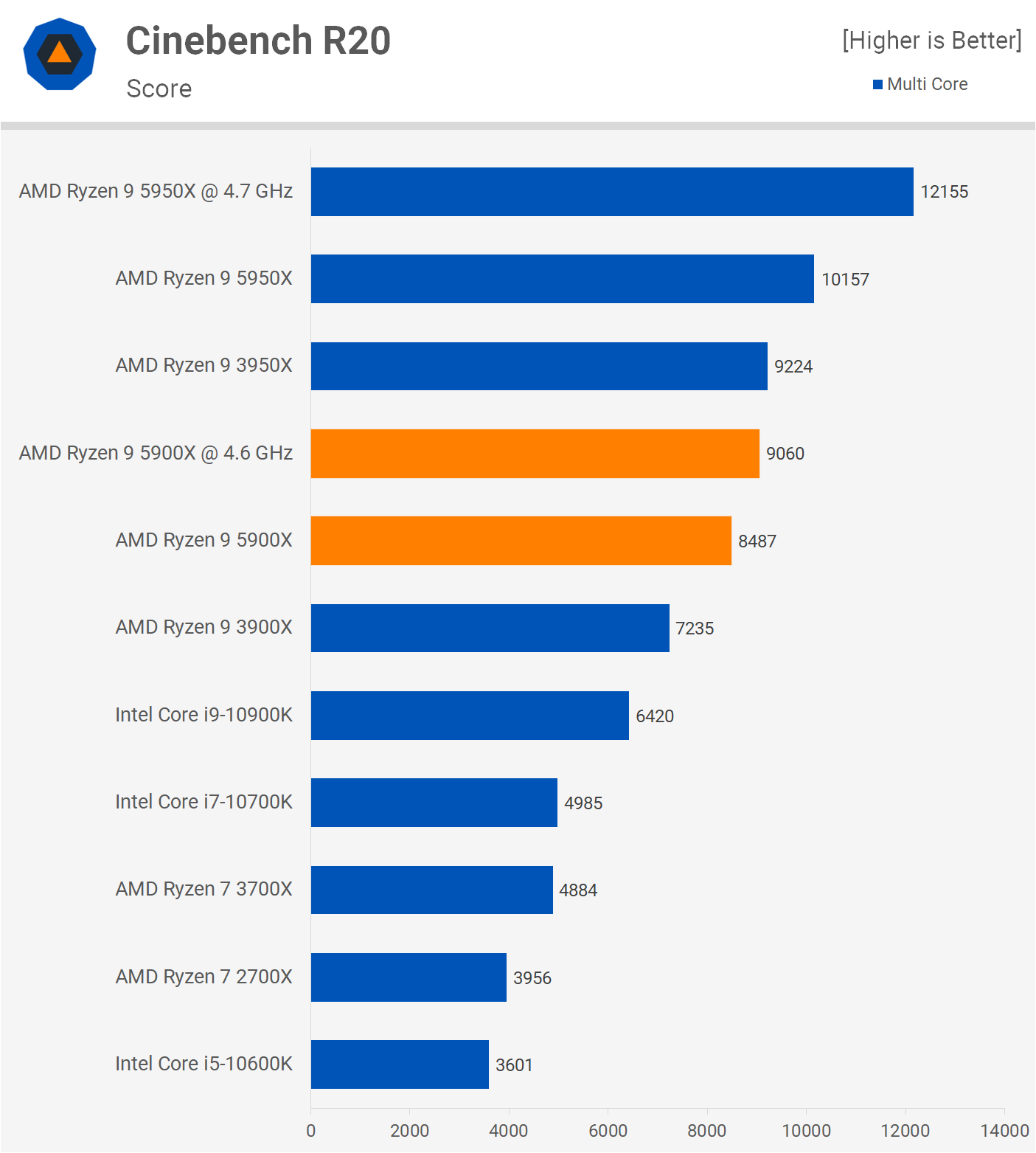
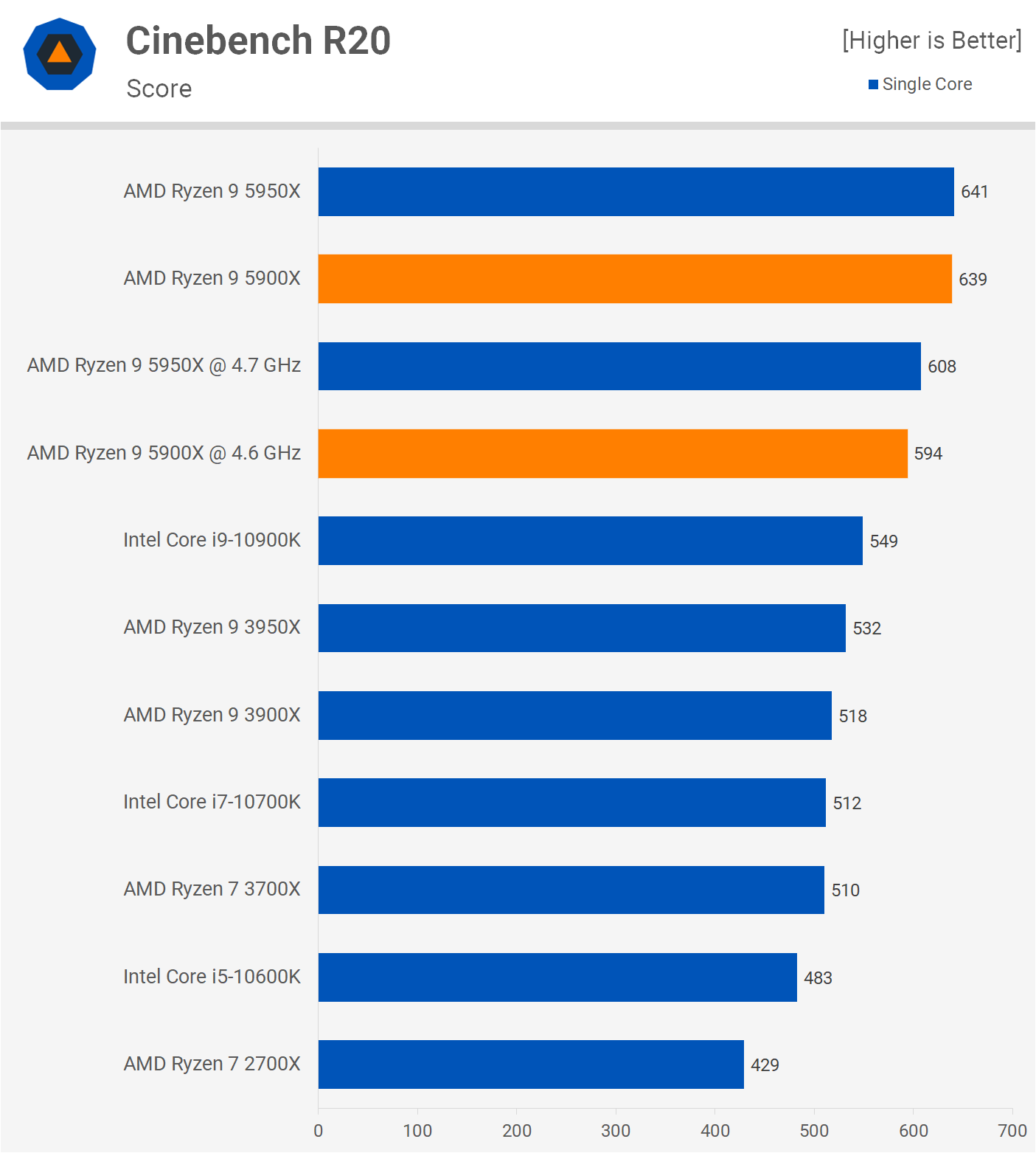
With that said, we can't recommend this overclock as it reduced single core performance. Previously, the 5900X hit 4.9 GHz in this benchmark, now we're limiting it to 4.6 GHz and that reduced the score by 7%.
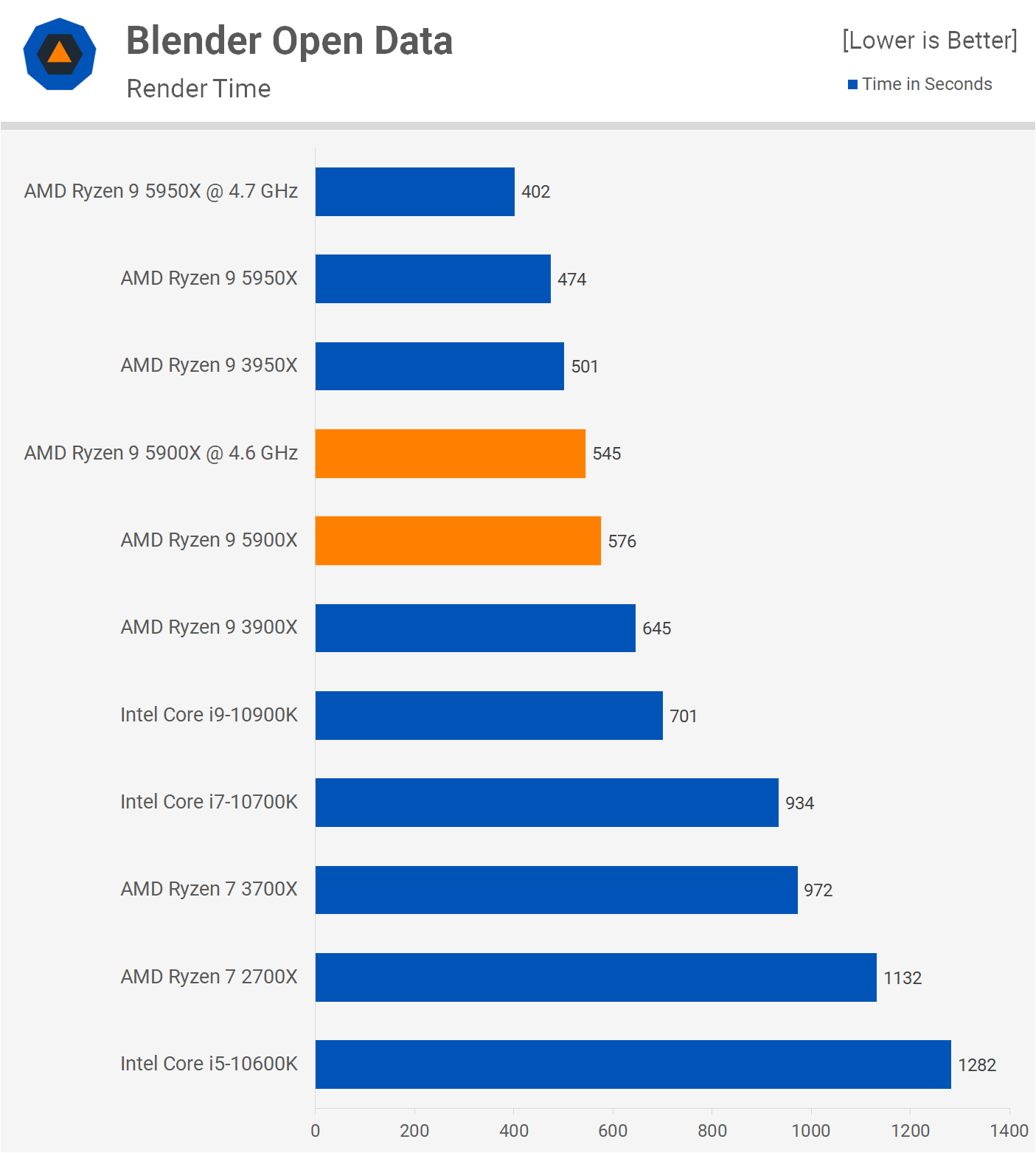
The overclock is useful for running core-heavy applications if you're happy to sacrifice efficiency for more performance. The gains aren't amazing as seen in Cinebench R20's multi-core test though, again we're only looking at a 6% performance boost.

For that 6% performance boost the total system consumption is increased by 16% and while that's still 11% less than a stock 10900K, it is a reduction in performance per watt.

For the most part, gamers won't want to overclock the 5900X, at least not the way we have. Perhaps per CCX overclocking will work out better. Here we're looking at a 5% performance reduction, though obviously you'll only see that when heavily CPU bound which isn't often the case in games.
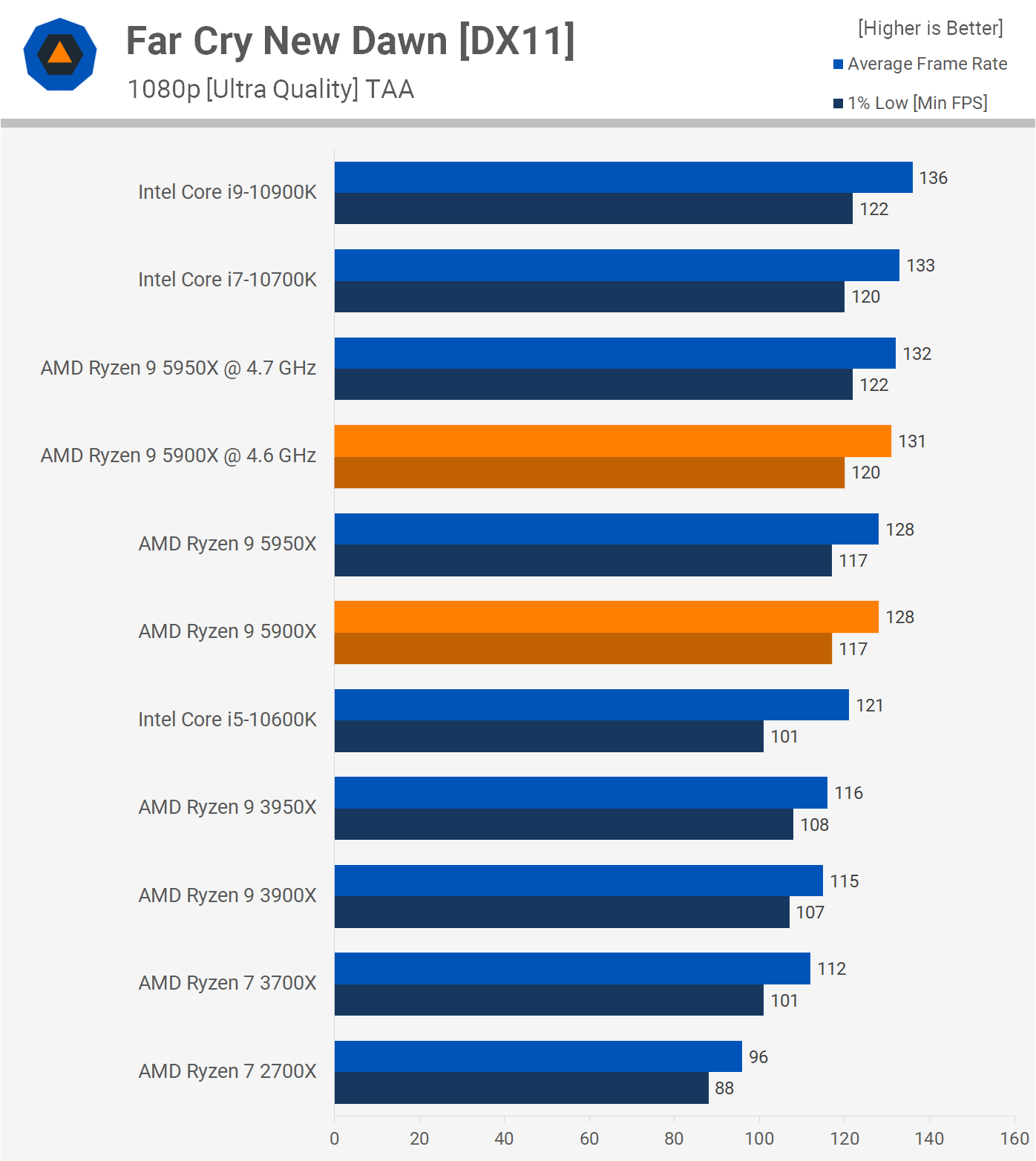
We do see a slight performance improvement in Far Cry New Dawn as the overclock increased the average frame rate by 2%, so that's something.
Price to Performance
Time for the price vs. performance analysis. Starting with Cinebench, we see that the 5900X comes out costing 25% less than the 10900K, with the Intel processor priced at $550, though we've seen selling as high as $600. It should be priced at $530, but with spotty availability, you'll find yourself paying a premium to get it.

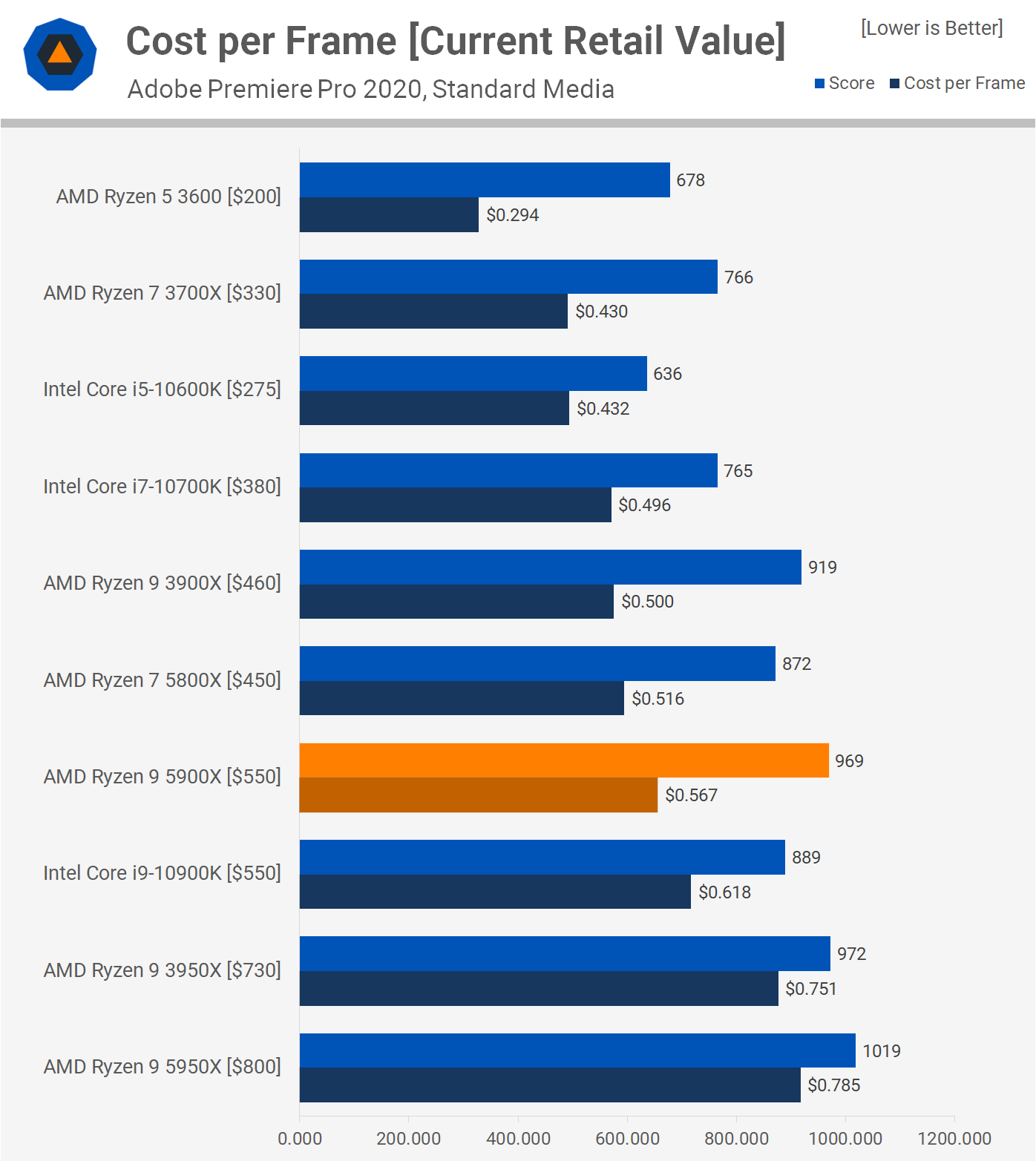
Using a less favorable program like Adobe Premiere, the 5900X is still seen delivering more value than the 10900K as it was 8% more cost effective. Not a major difference, but as we said, this was one of the less favorable applications for the 5900X.
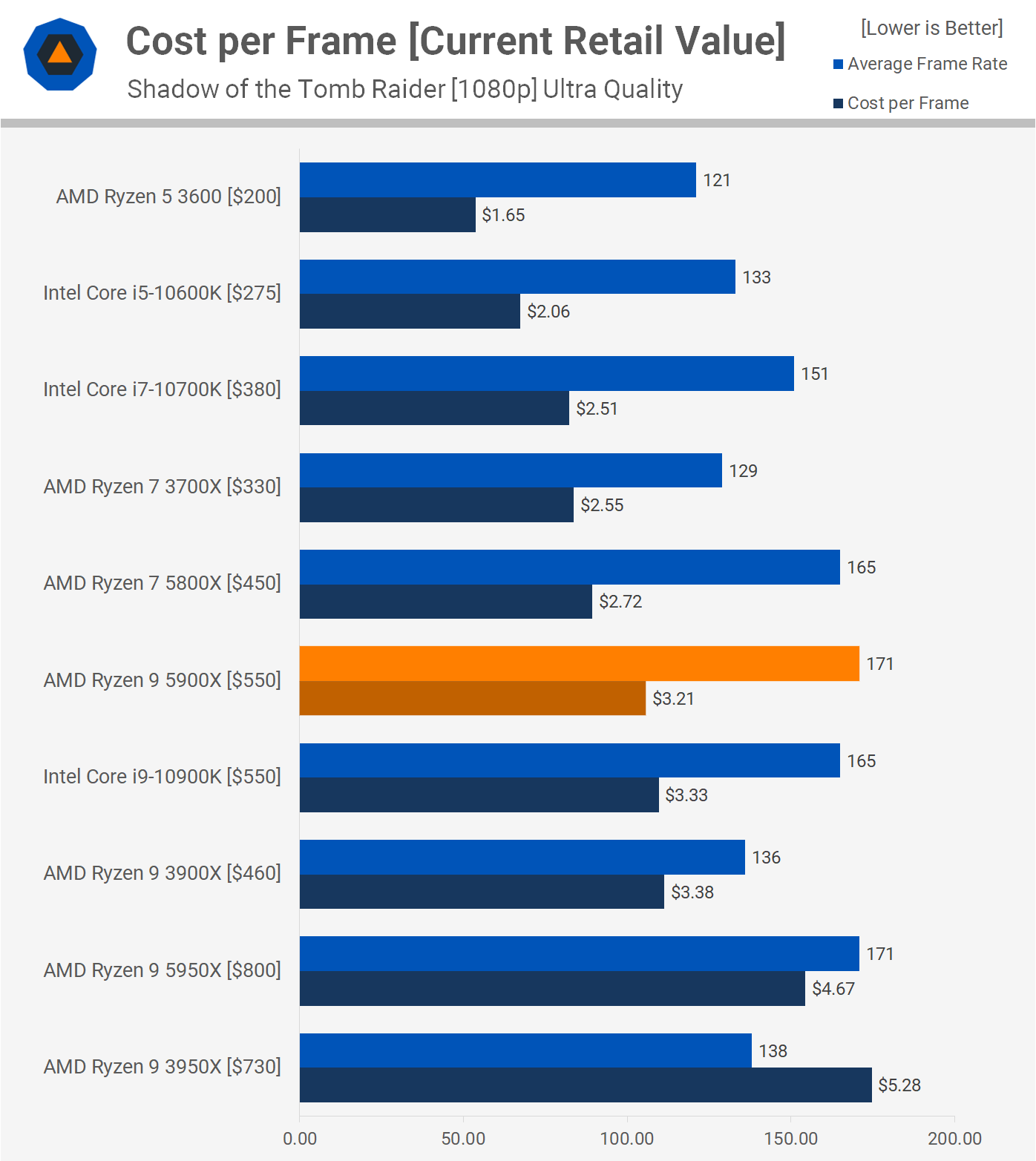
Despite currently costing almost $100 more than the 3900X, the 5900X still costs 5% less per frame. When compared to the 10900K, it was just 4% cheaper per frame.

The 11 game average looks slightly different. Basically the 5900X offers the same level of value for CPU-limited gaming as the 3900X, despite costing $90 more in our comparison. Also, when compared to the 10900K we're looking at the same level of value for gaming.
What We Learned
We've gotta say, as impressive as the Ryzen 9 5950X is, we found reviewing the 5900X a little more interesting, mostly because it has a direct competitor in the same price bracket. The Ryzen 9 5900X is a more wallet-friendly CPU and possibly the more popular of the two for those looking to build a high-end system.
For gamers, it makes a lot more sense. The question now is, for gamers looking to build a high-end system, which CPU should they buy, the 10900K or the 5900X? For the vast majority of people, it's not going to make a real difference. Performance is going to be roughly the same, and even when CPU limited 99% of the time, you won't be able to tell the difference. Looking into the future, the 5900X is the more powerful of the two overall and also has more cores to boot.
When looking at the newer, more demanding games such as Death Stranding and Serious Sam 4, for example, we see that Ryzen leads by a good margin. Therefore we foresee a situation in 1 to 2 years where the 5900X is leading the 10900K by a comfortable margin in most demanding titles, though that's entirely speculation on our part based on what we've seen today.
For the most part, you're likely going to be GPU limited when gaming, and that means you're even less likely to notice the difference between the 10900K and 5900X on the short term. The 5900X does have the advantage of greater power efficiency. There's also PCI Express 4.0 support in newer motherboards, which will prove beneficial at some point in the future.
Then for those of you running any kind of application, especially a core-heavy workload, the choice is more obvious. Worse case scenario, the 5900X is only slightly faster. Best case, it's around 40% faster and typically we saw gains in the 20-30% range.
For now Intel looks to be out of the game at the high-end, and we suspect things are only going to get worse for the blue team as we work down the Zen 3 product stack. The Ryzen 9 5900X is a mighty good CPU and for the 10900K to be considered an option, in our opinion it'd need to be priced at no more than $500, or less considering the the lack of PCIe 4.0.
Stay tuned tomorrow when we review the Ryzen 7 5800X.
